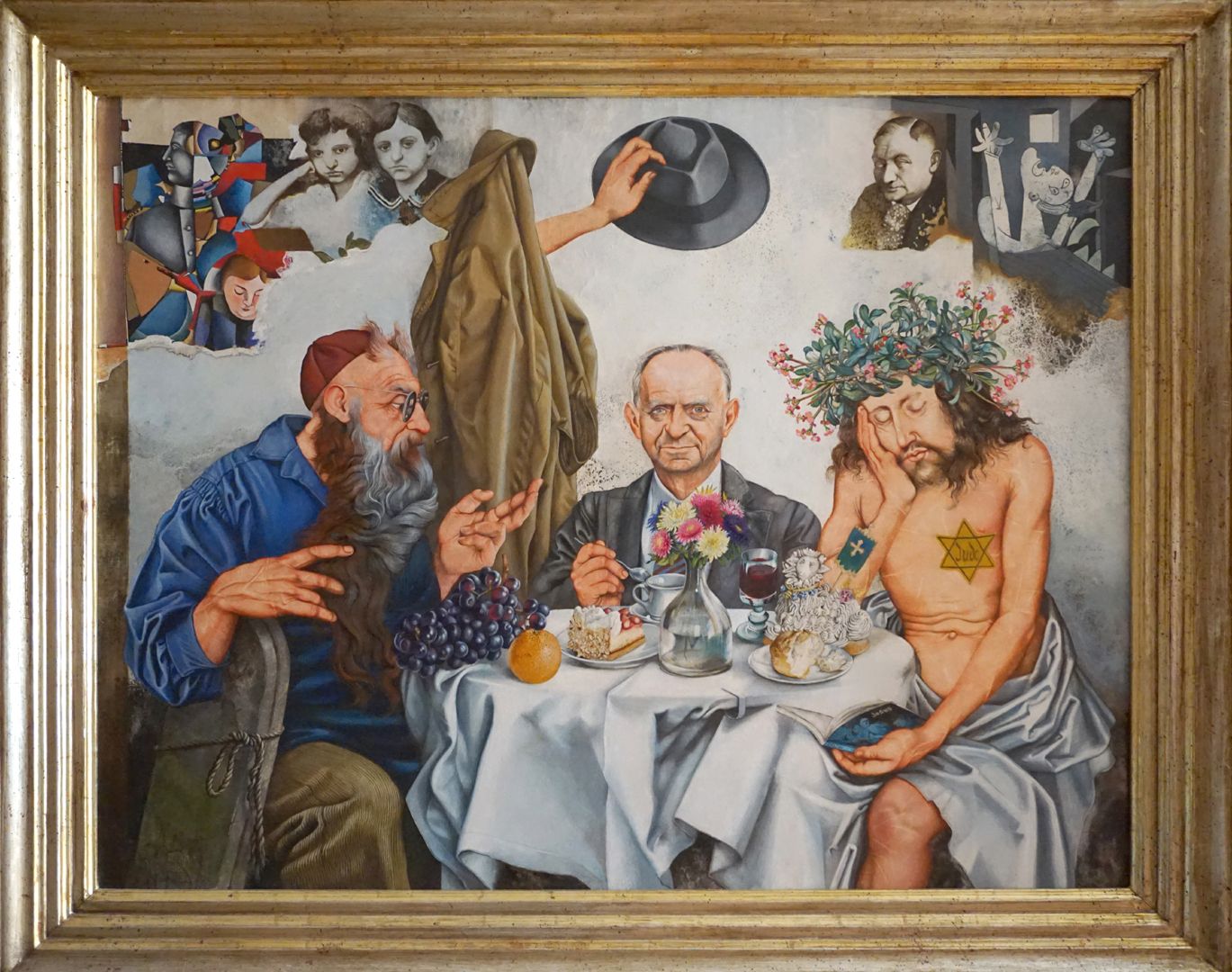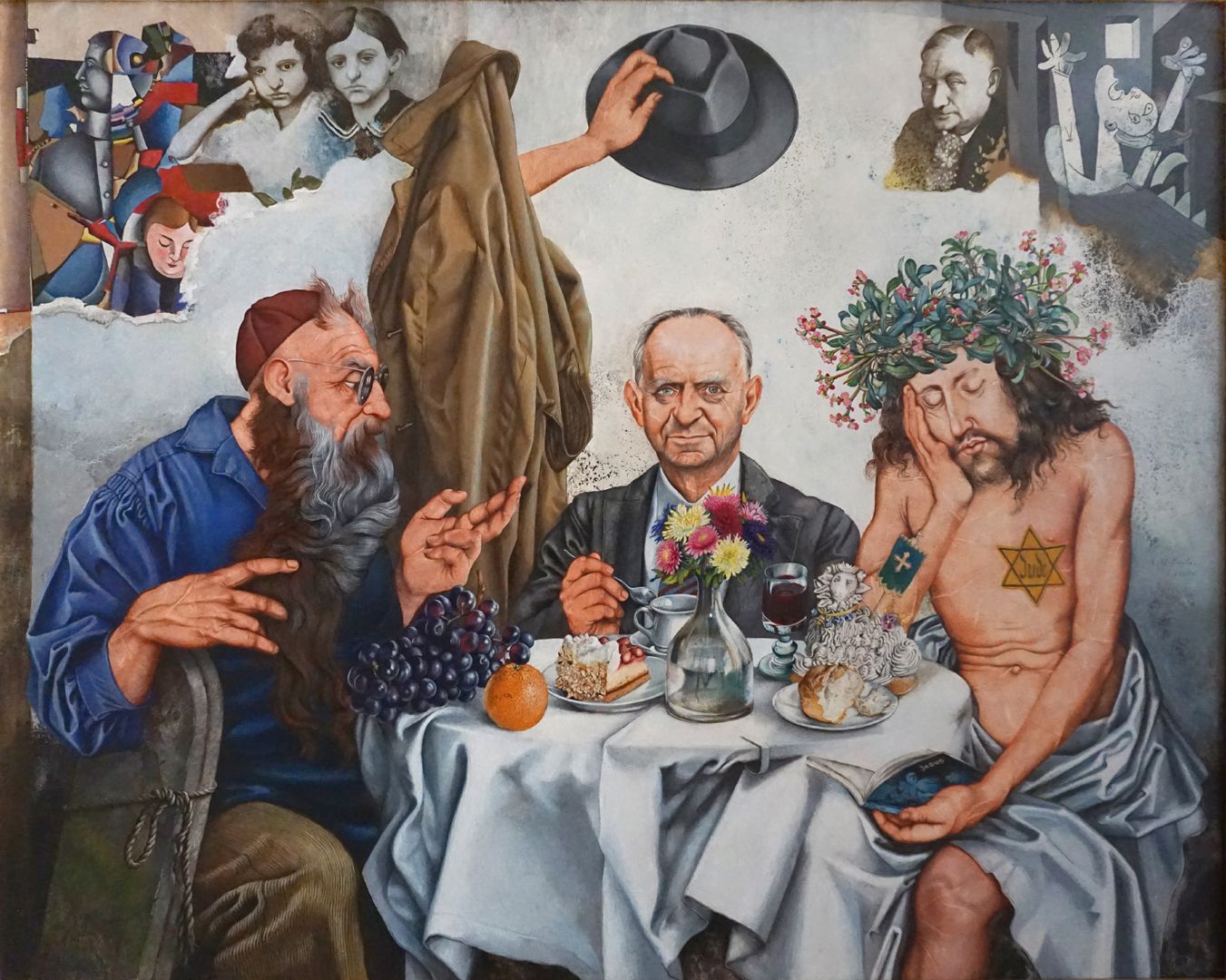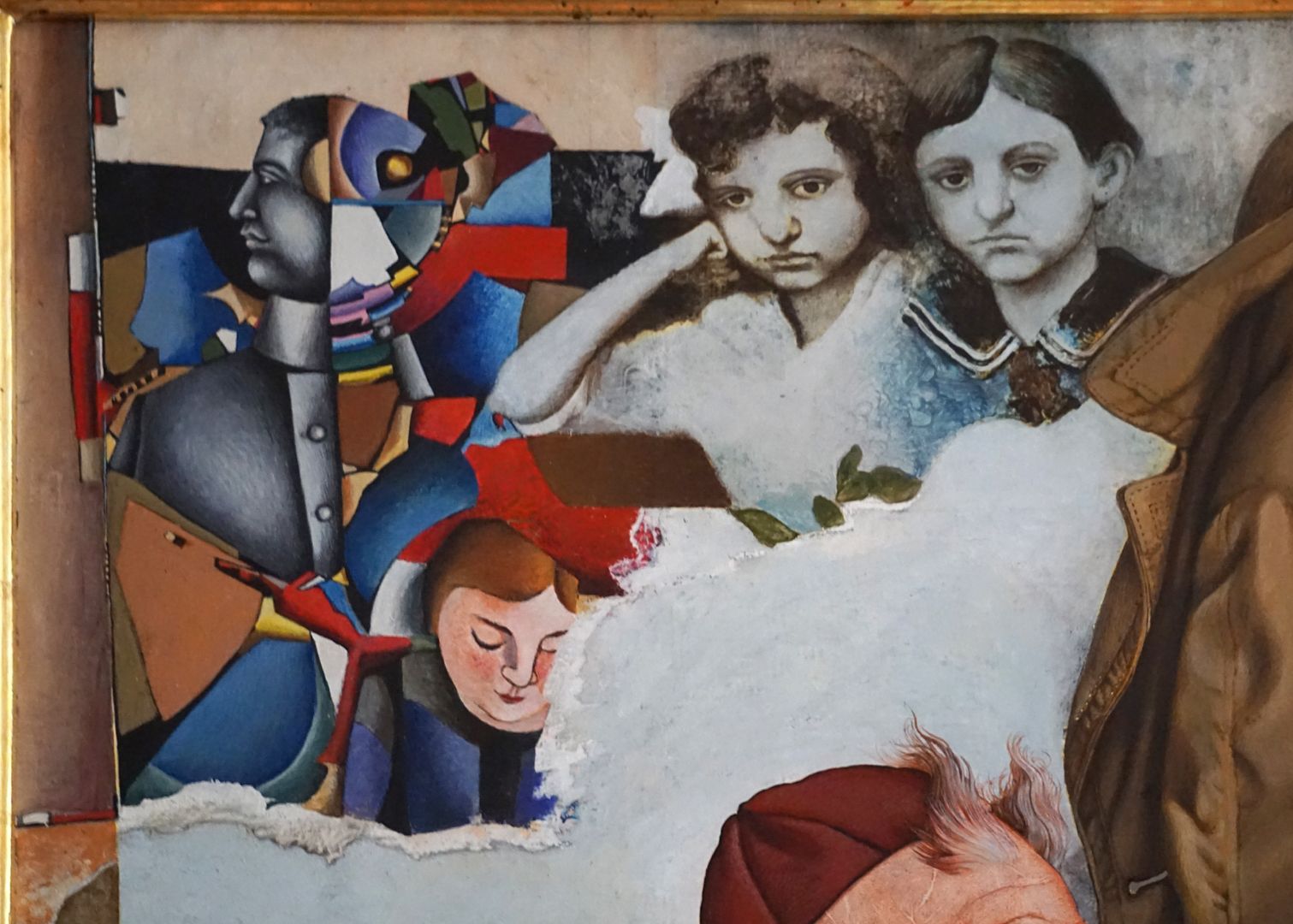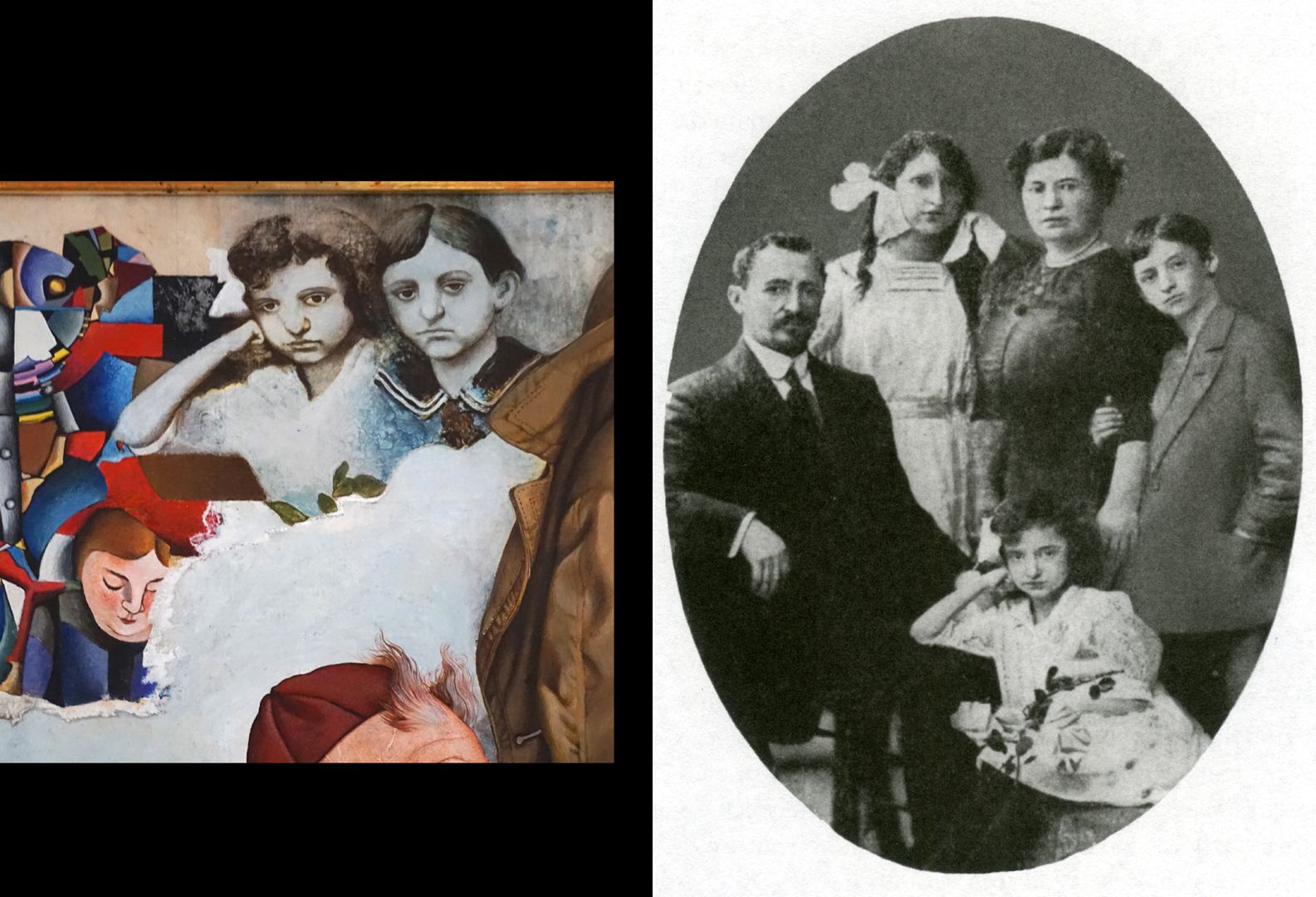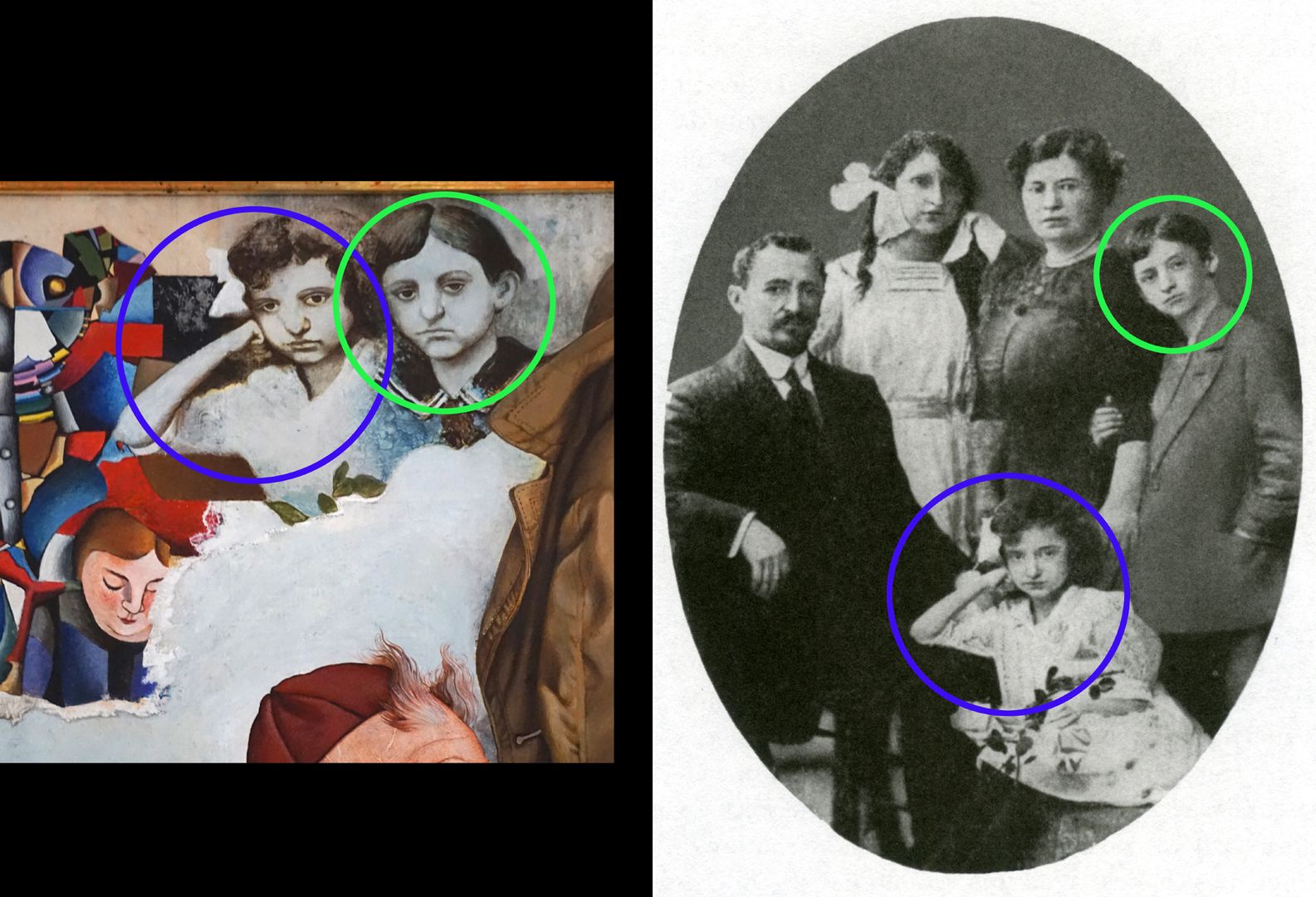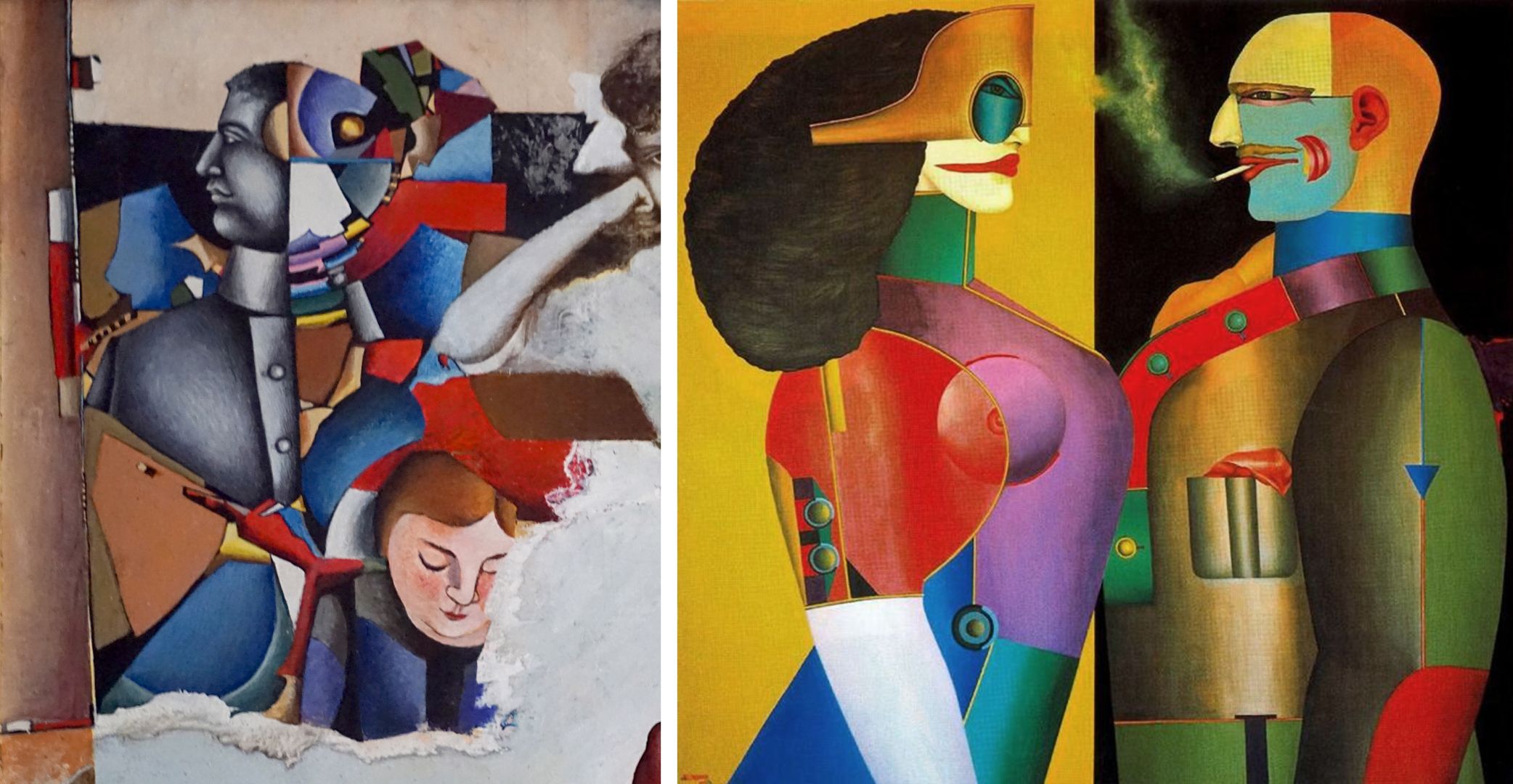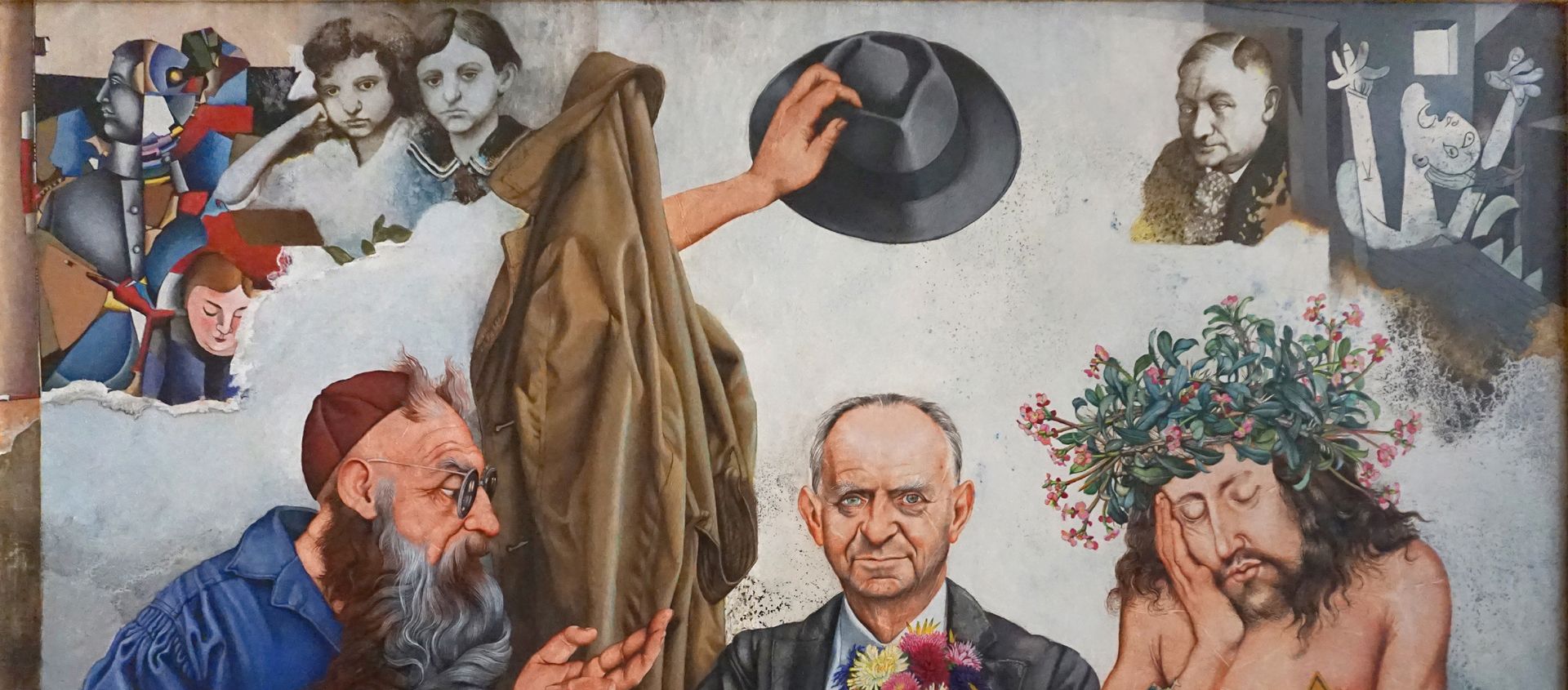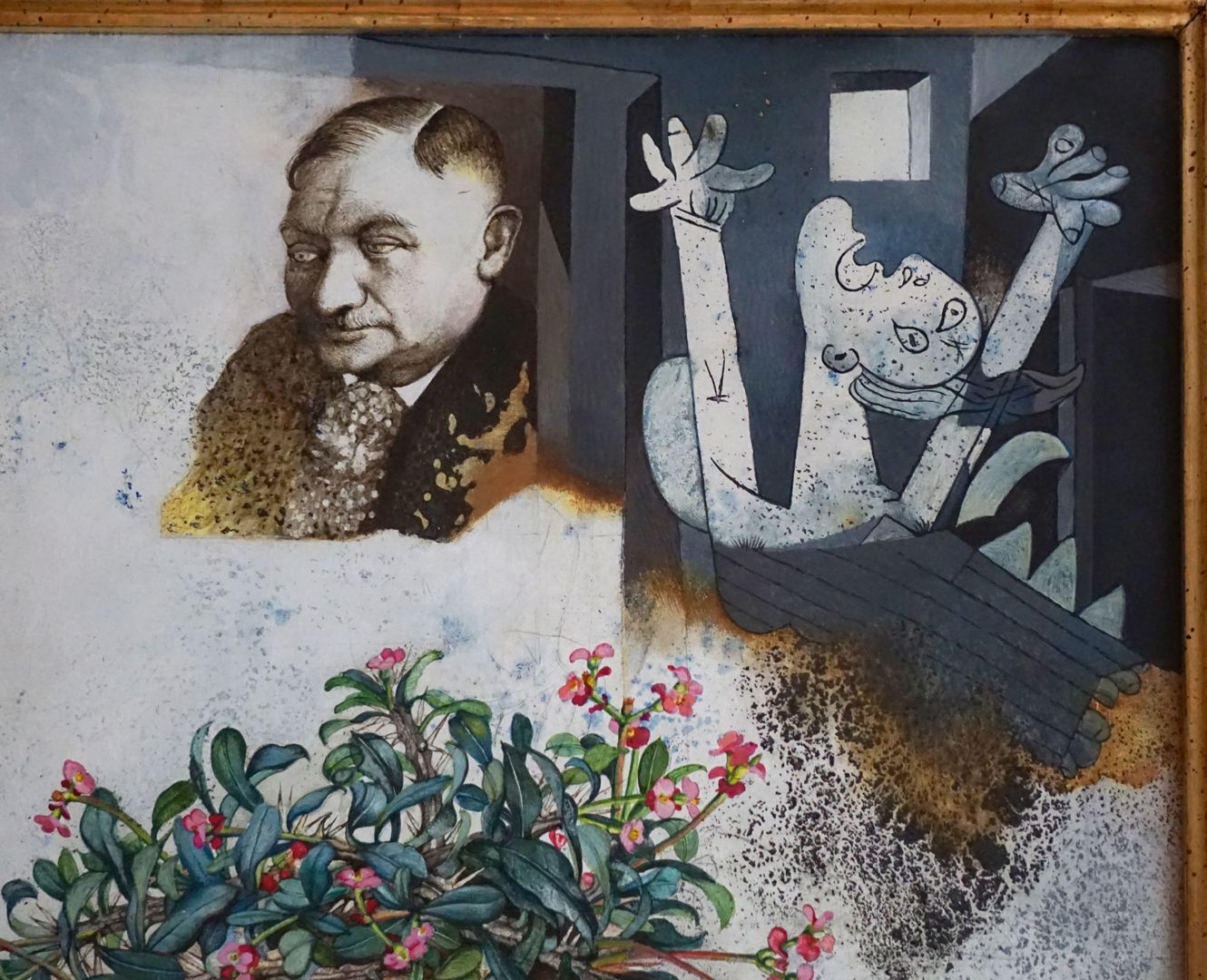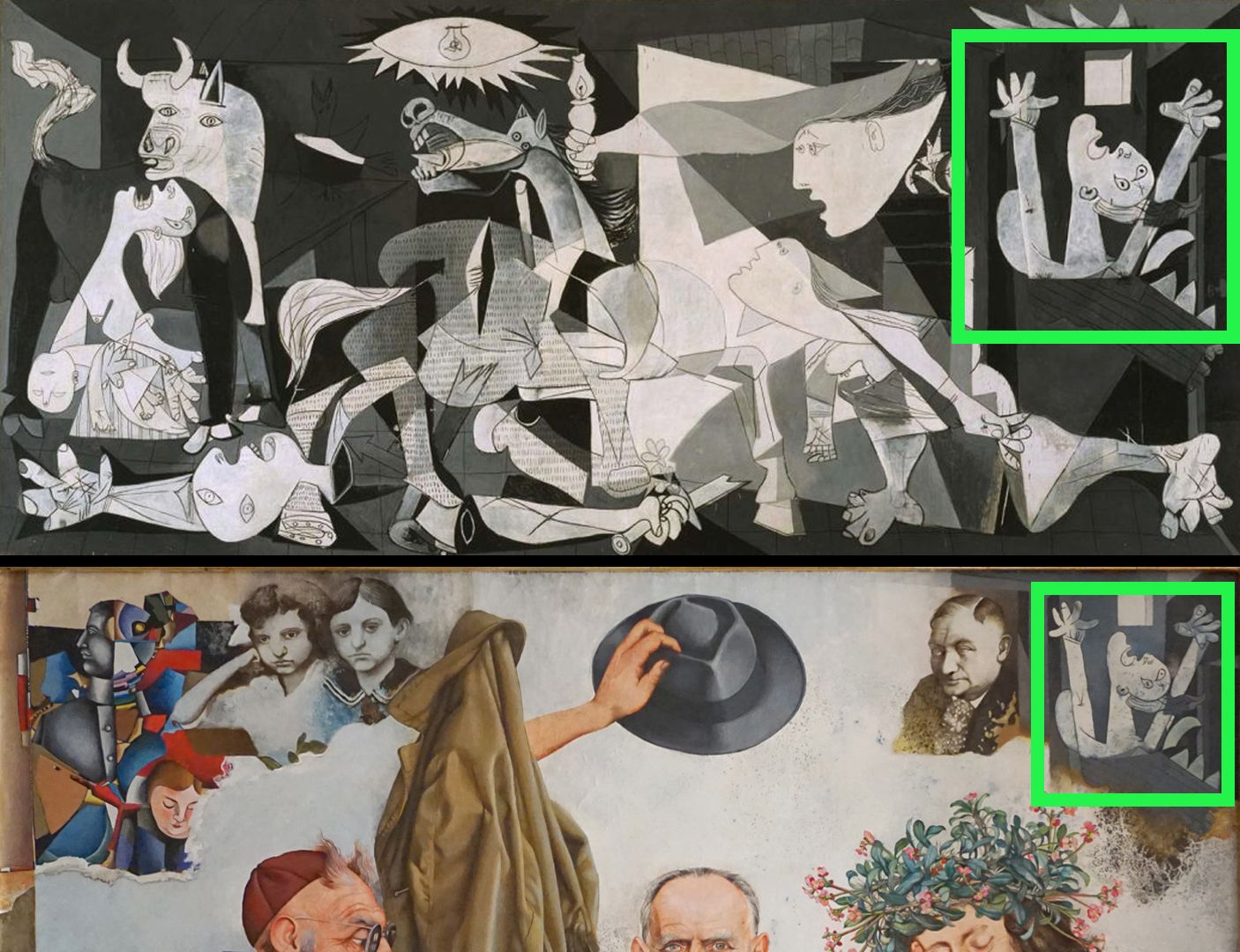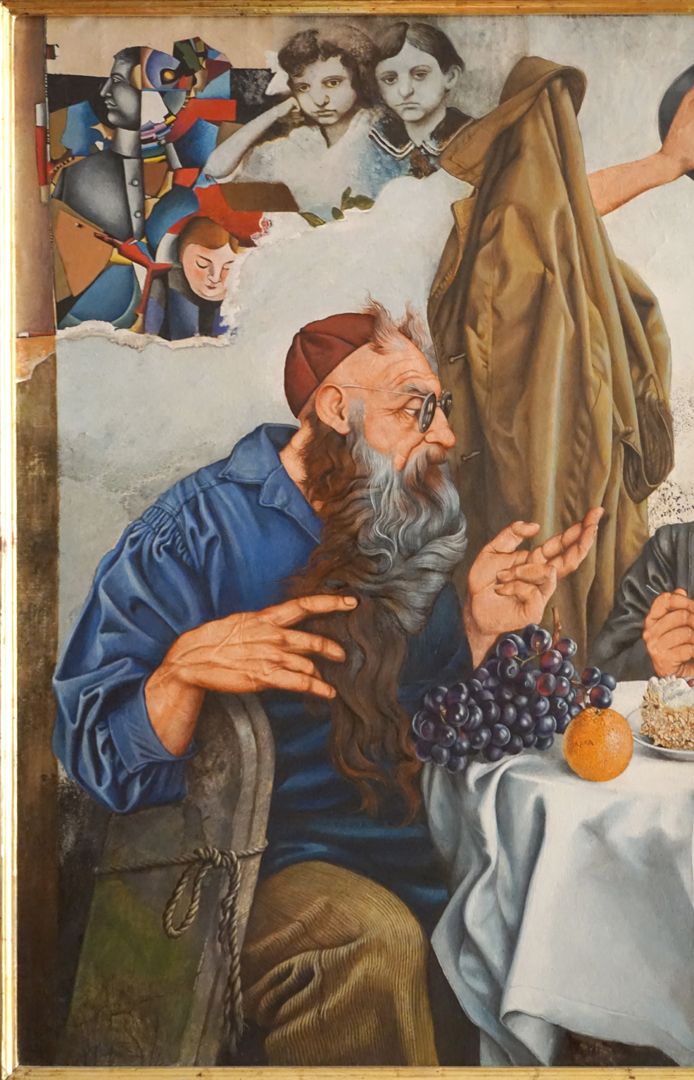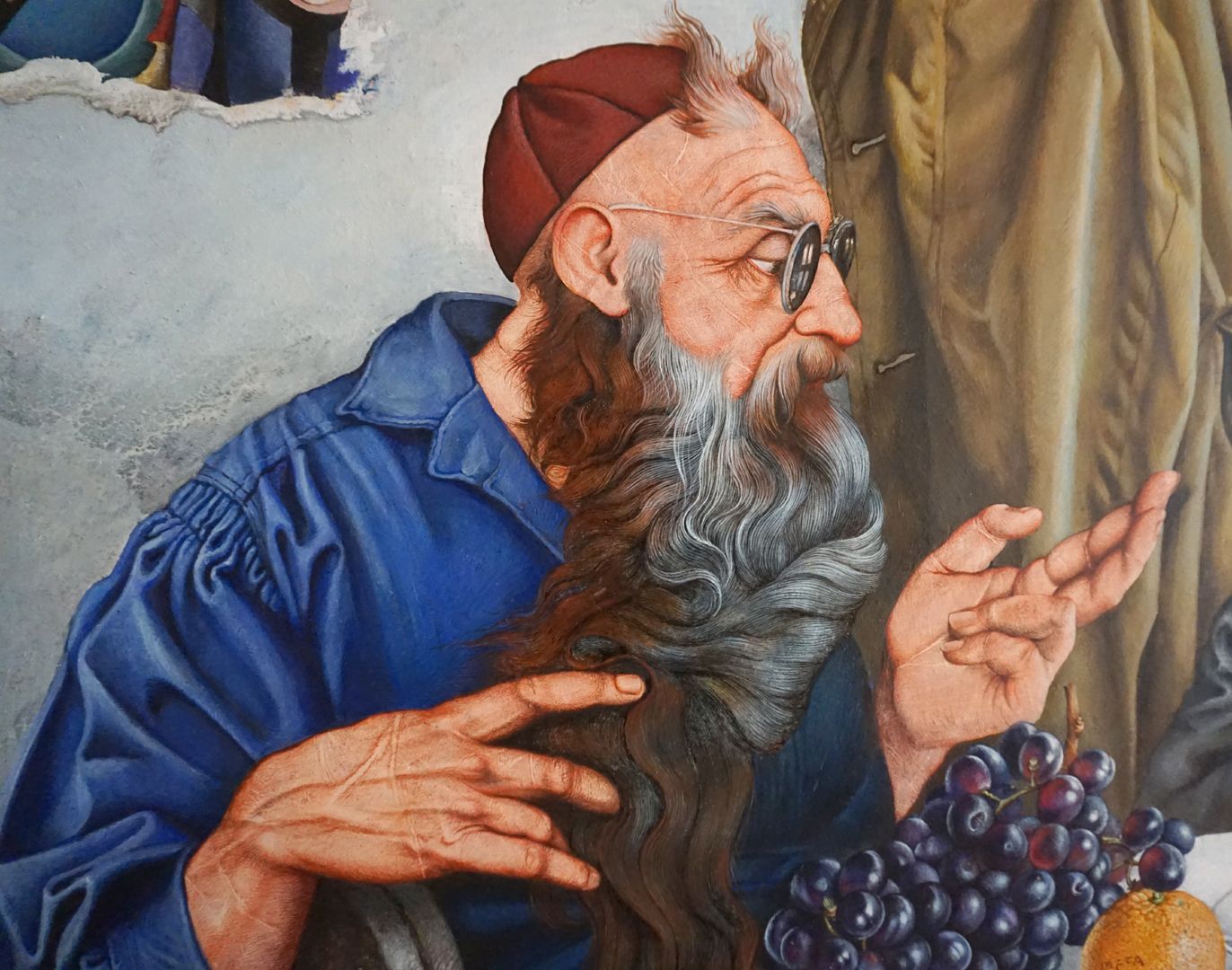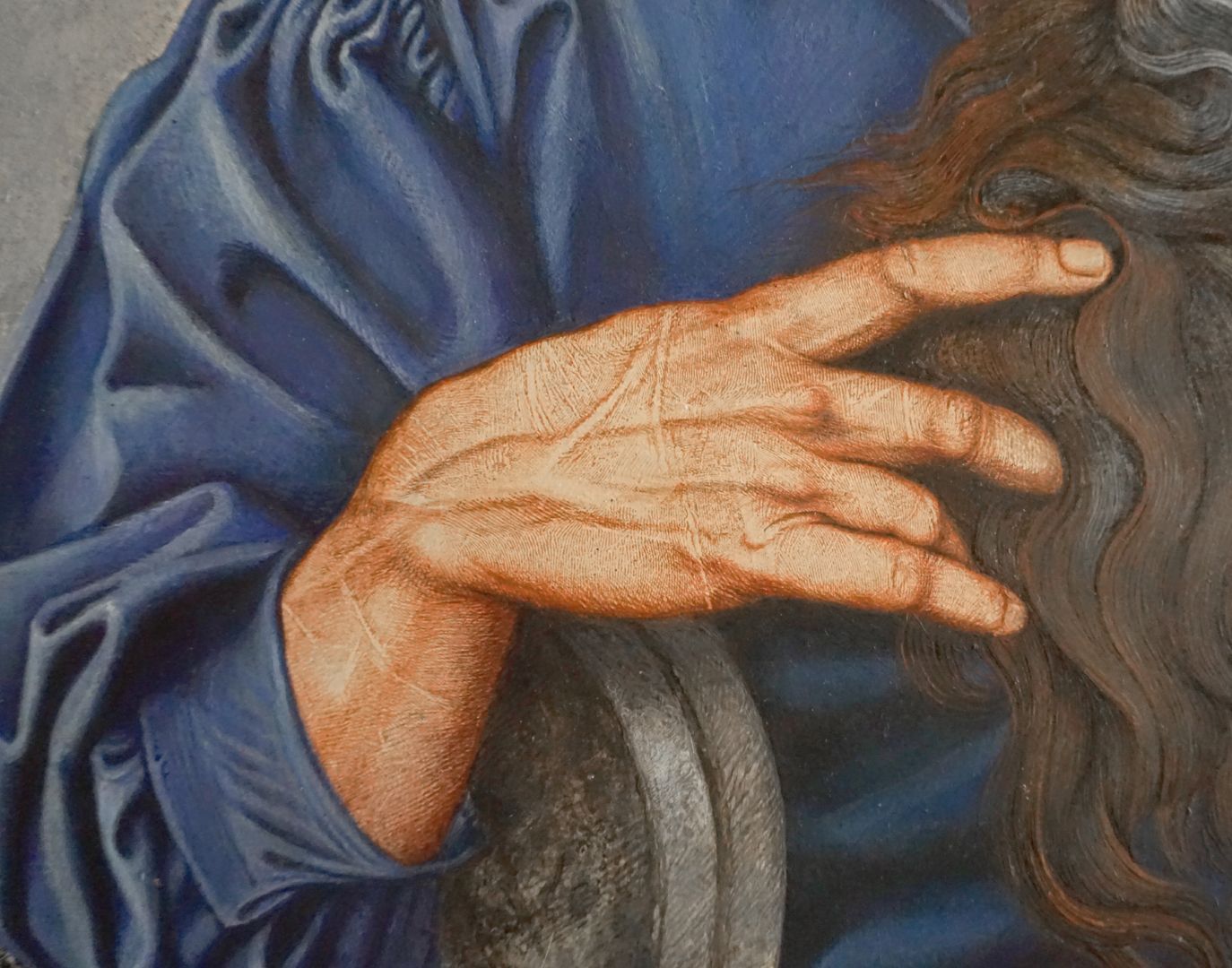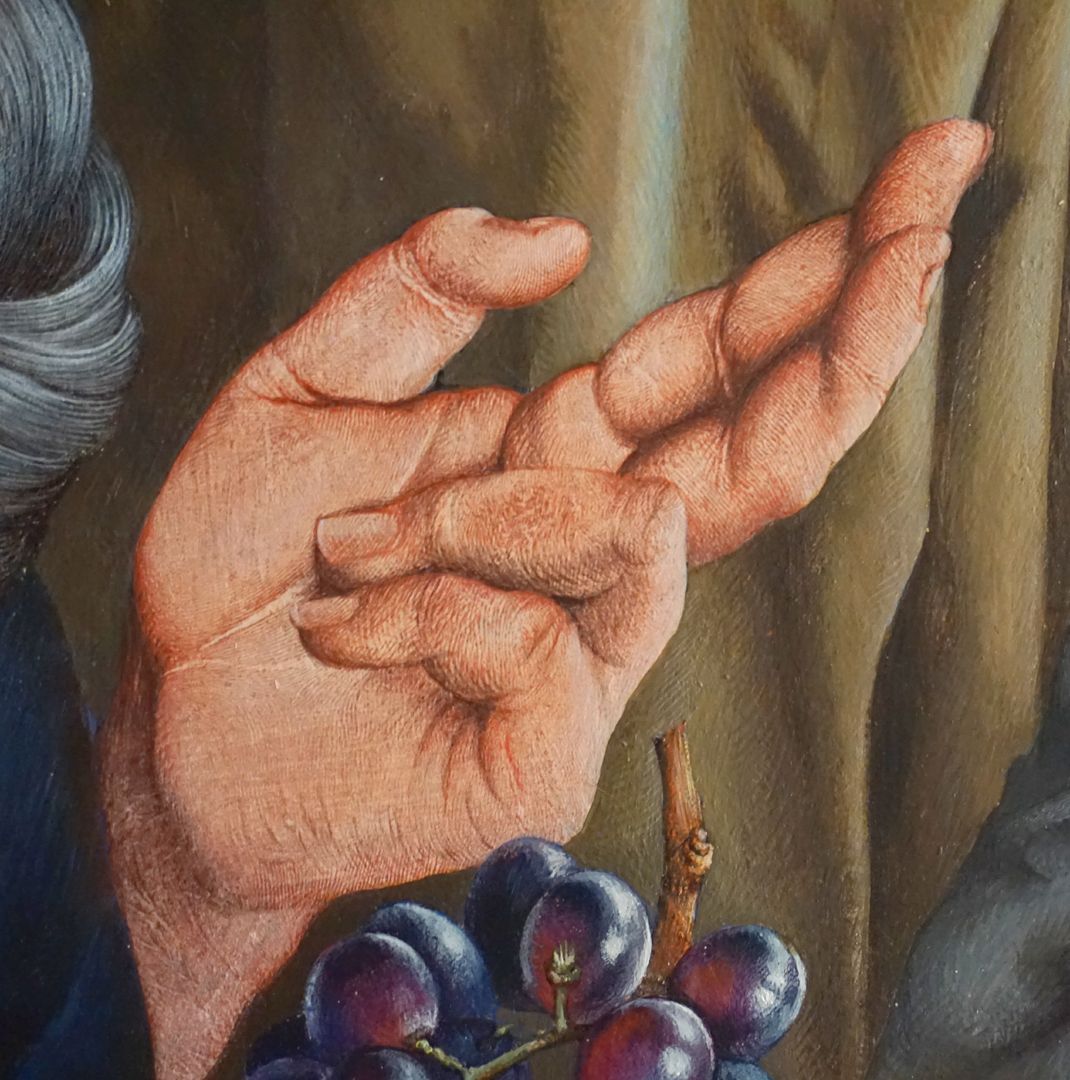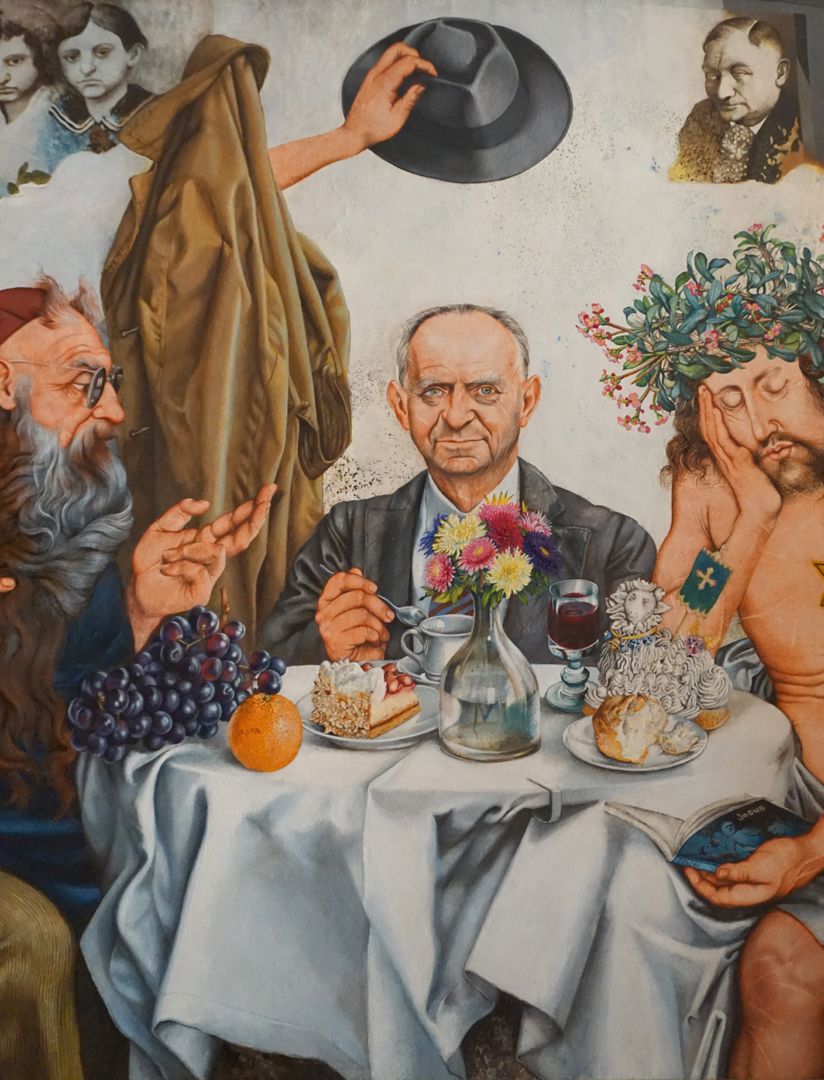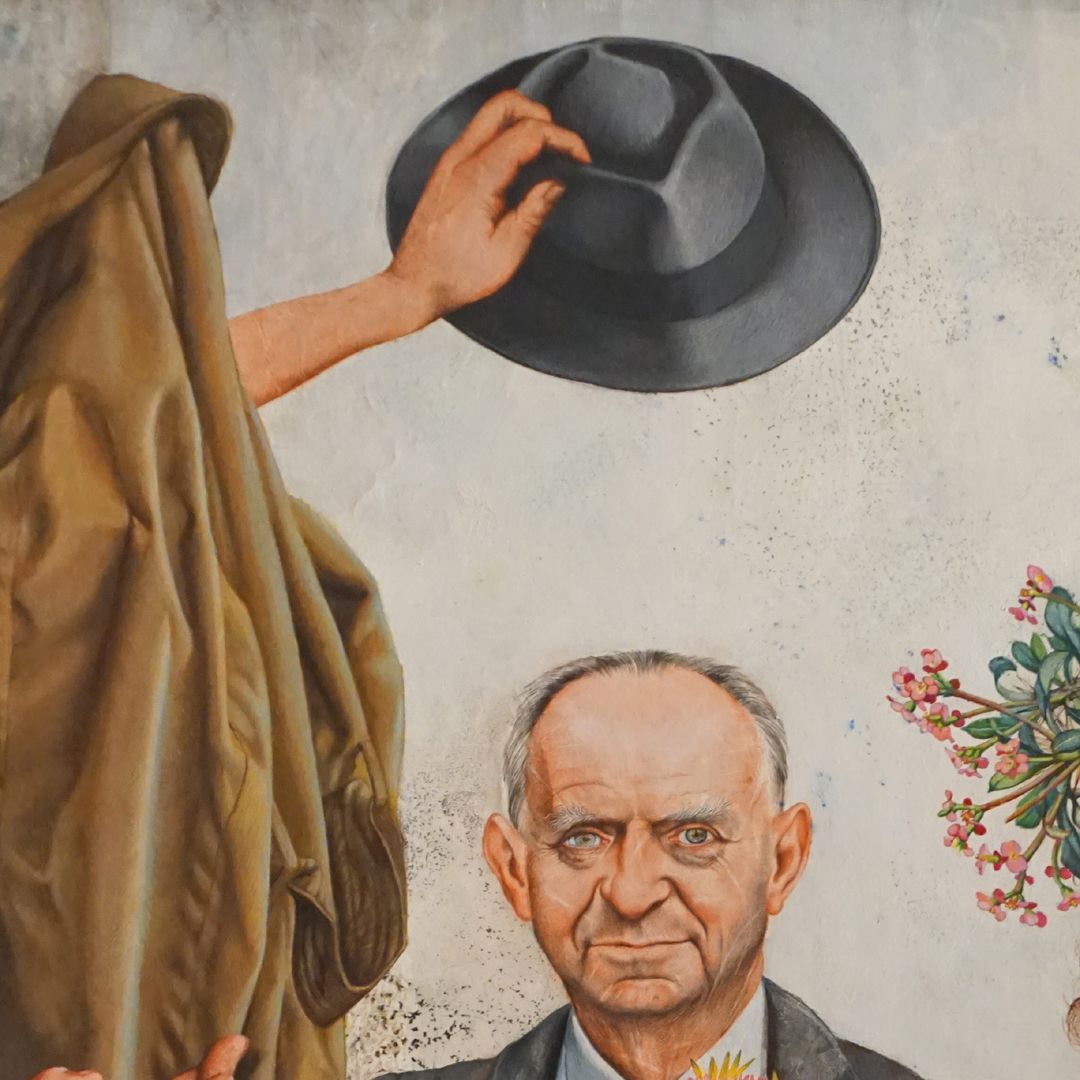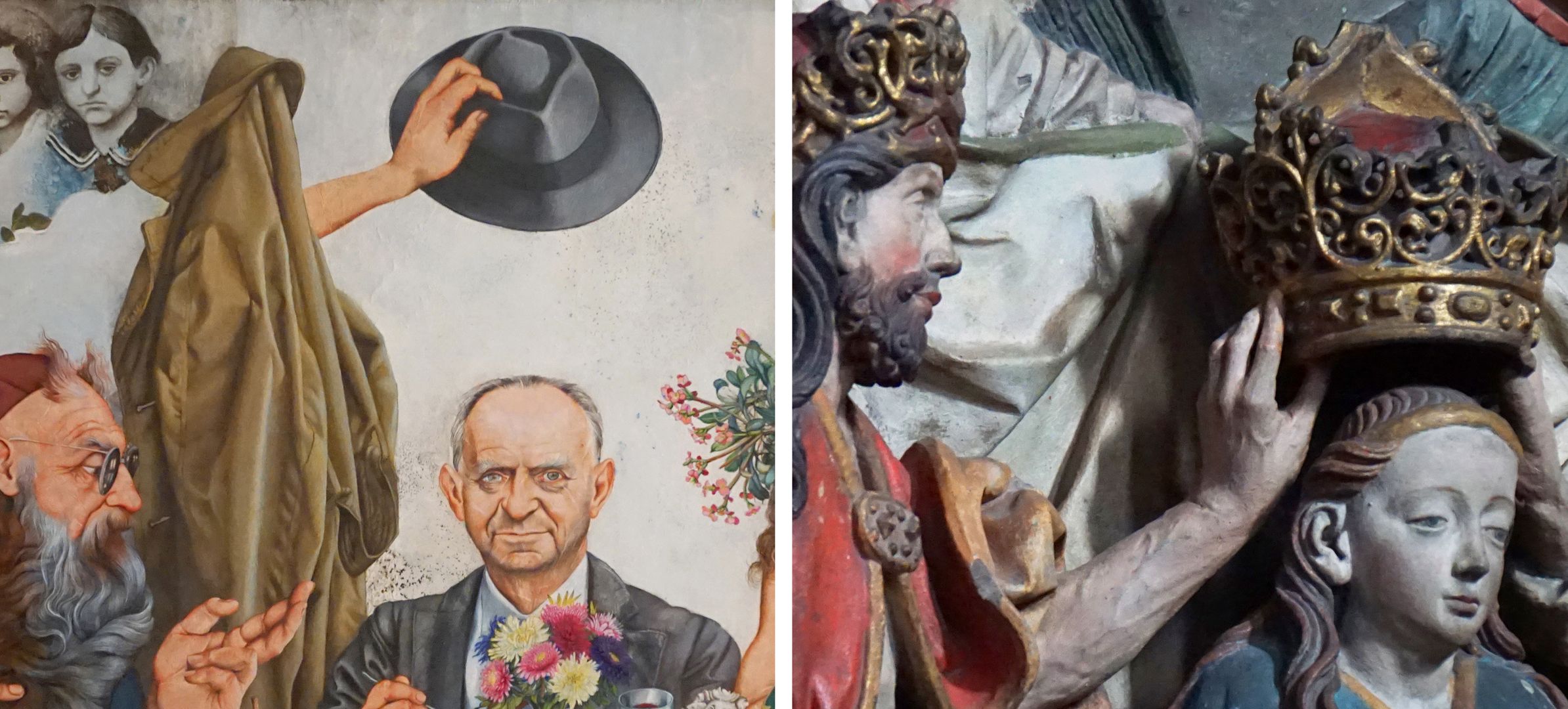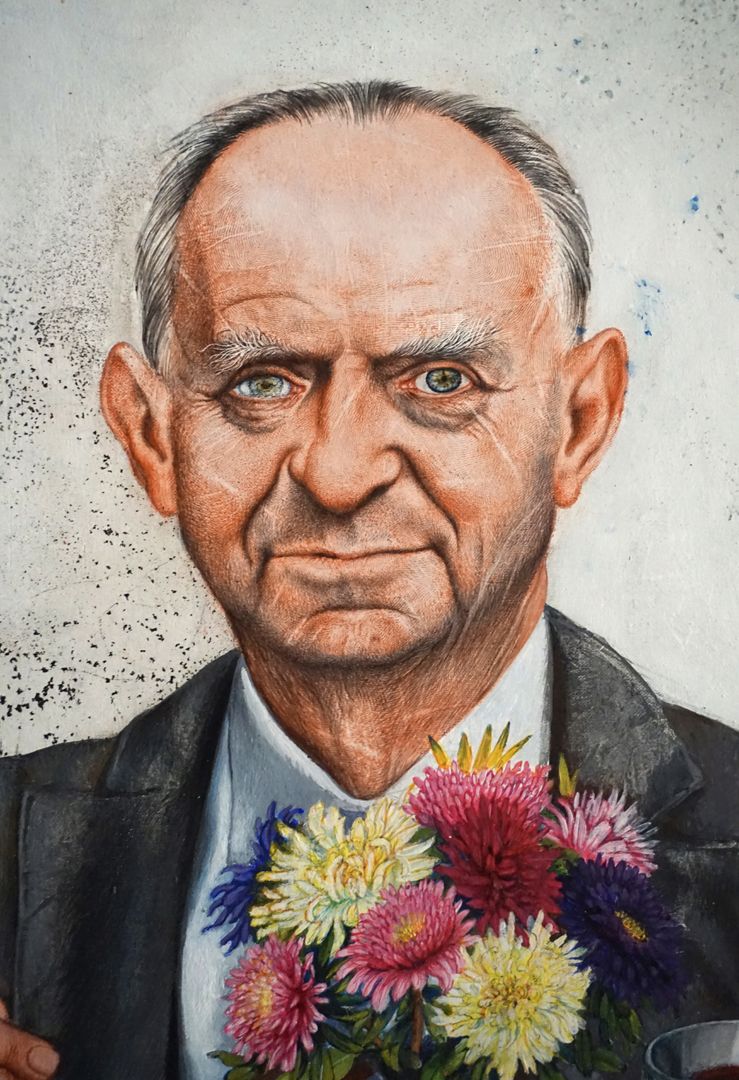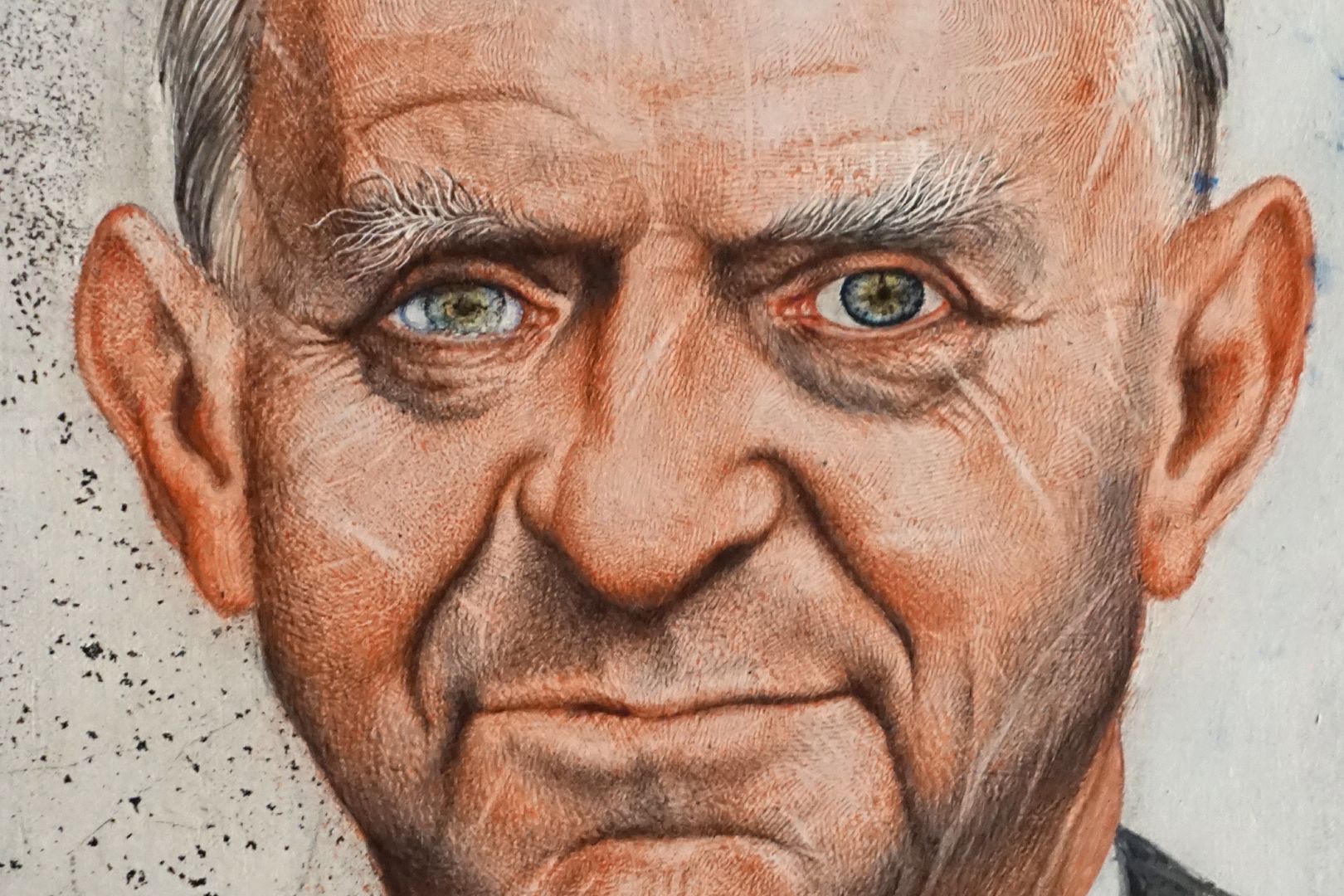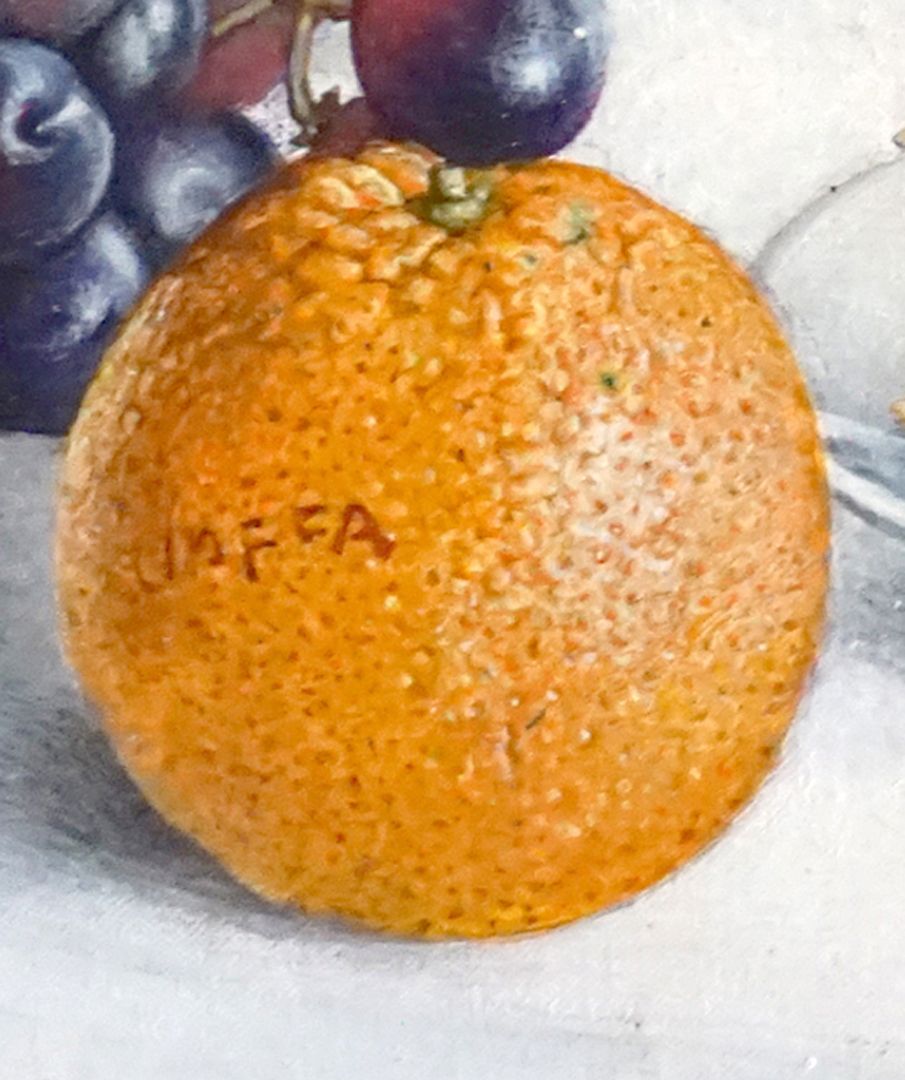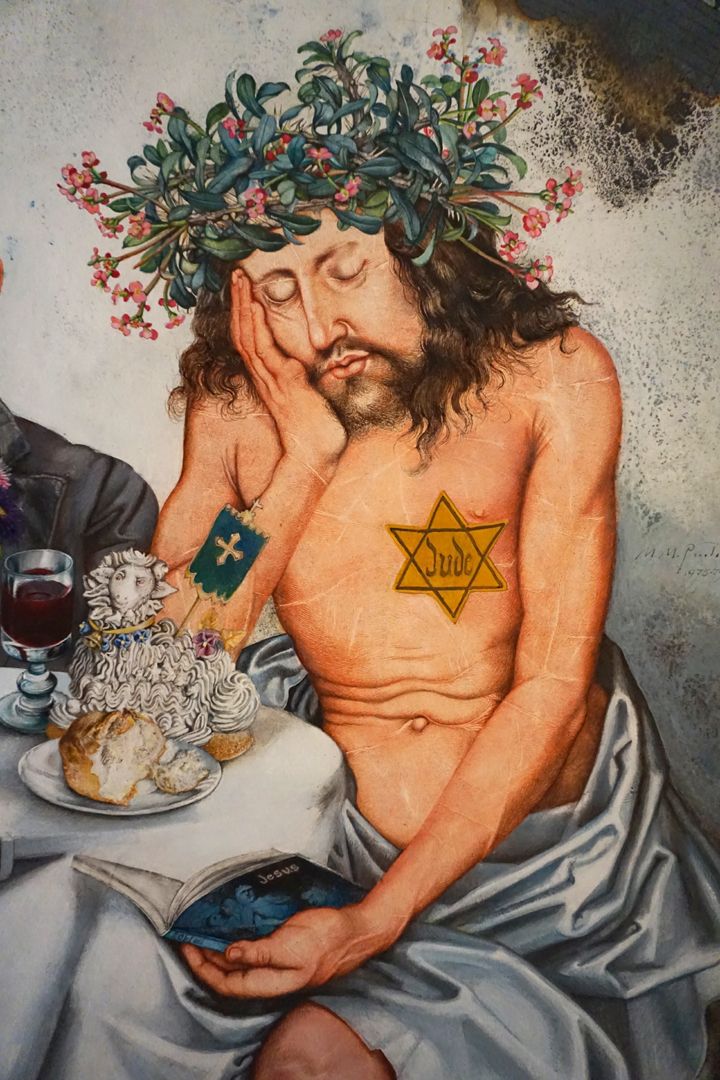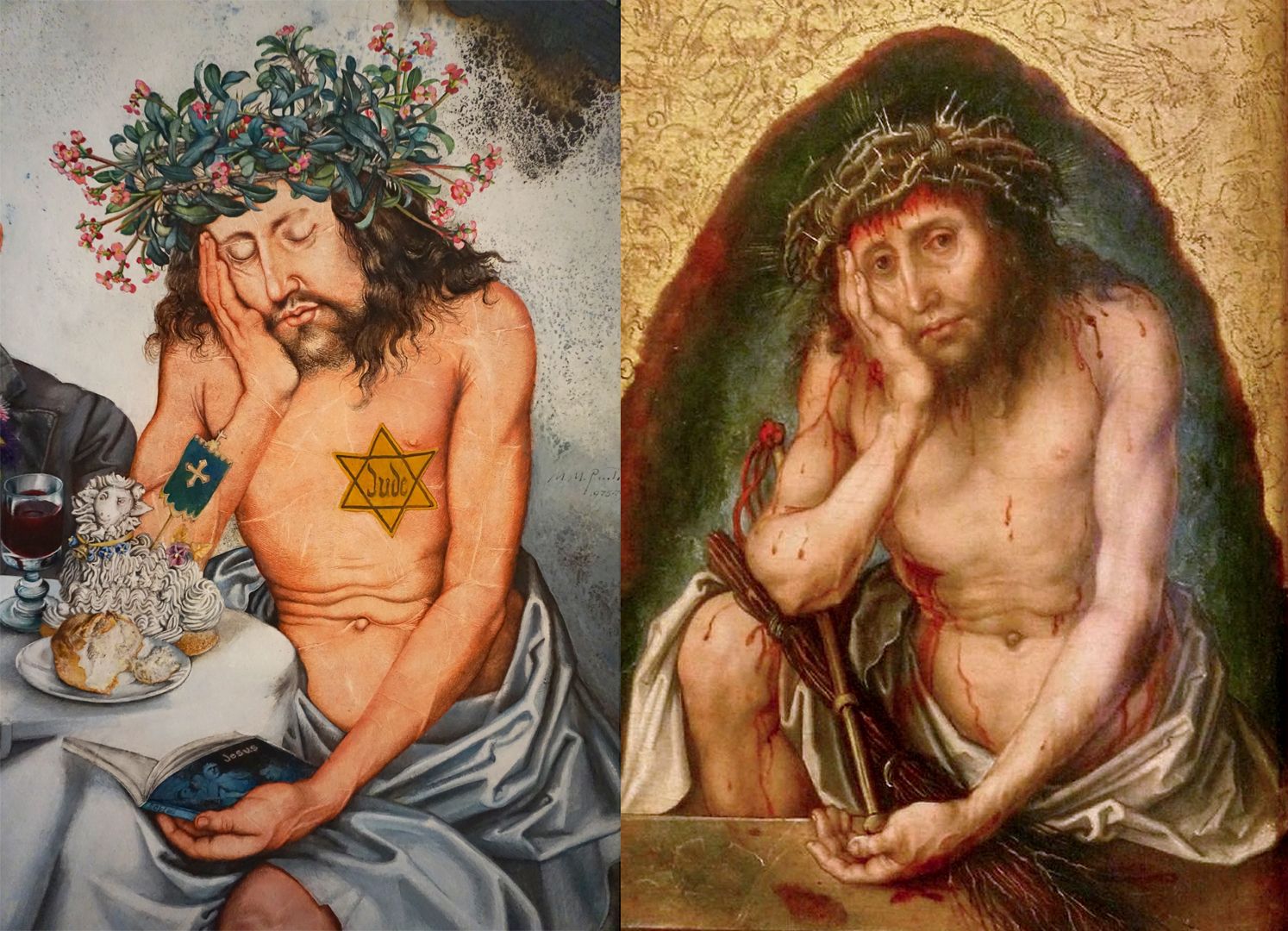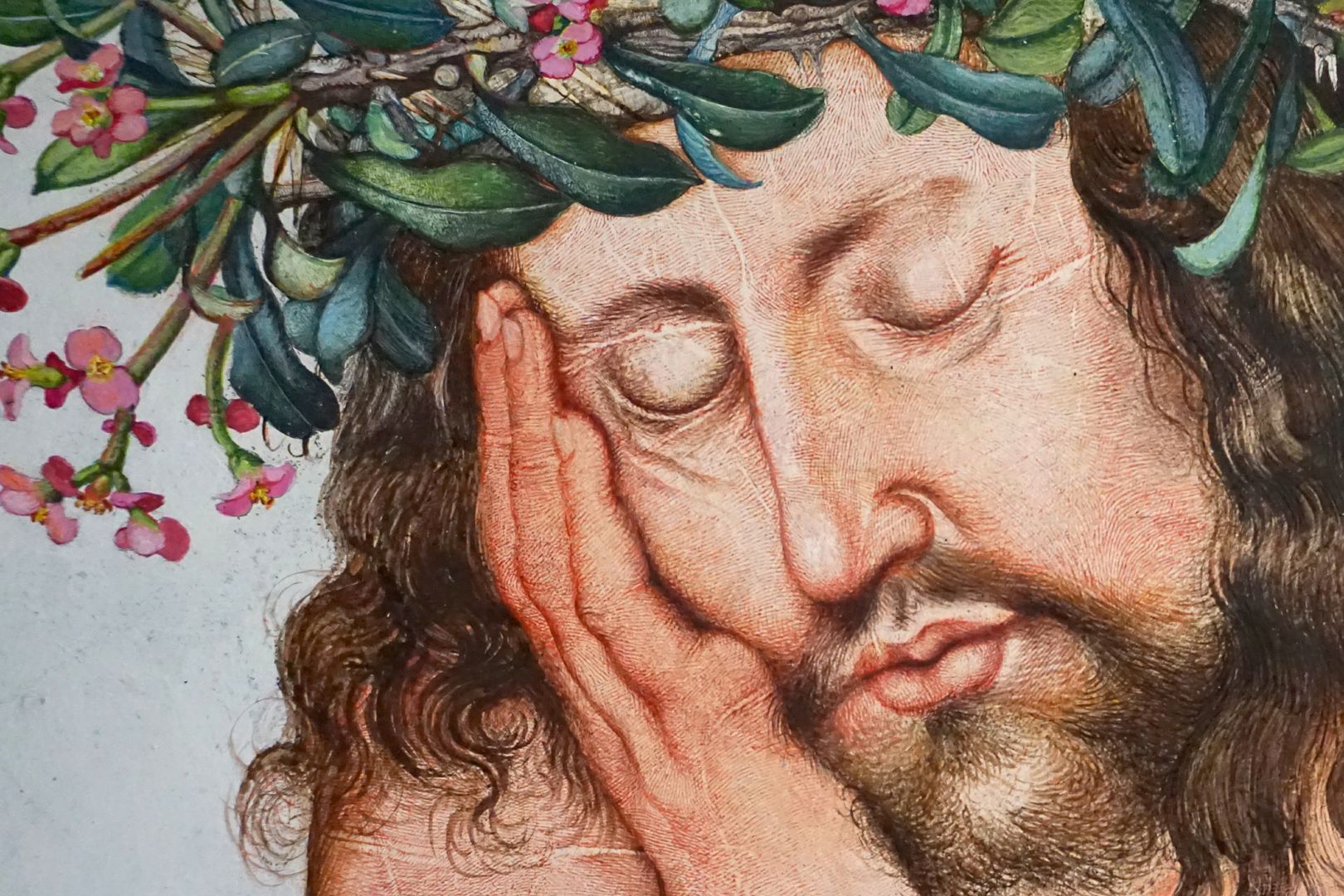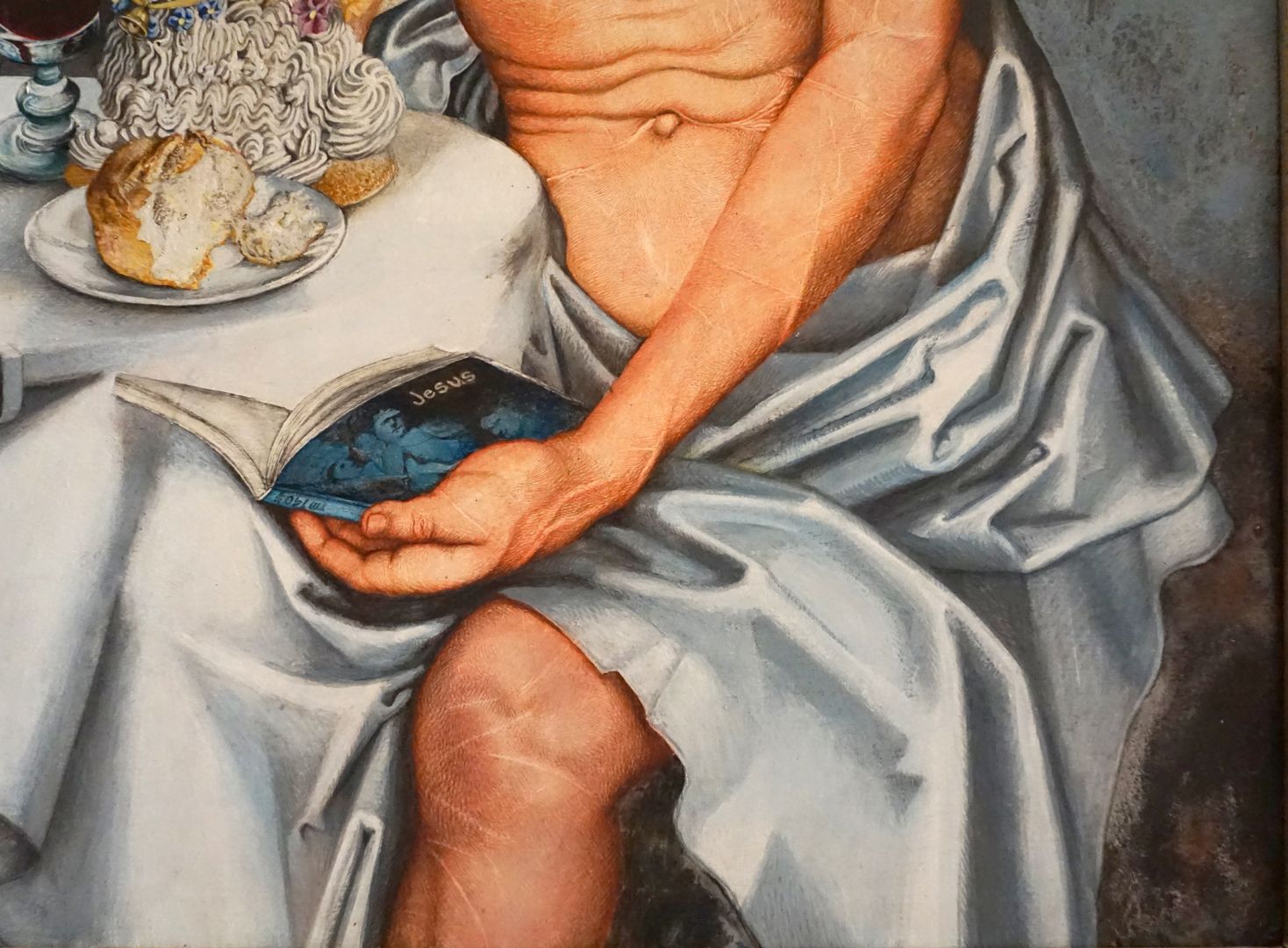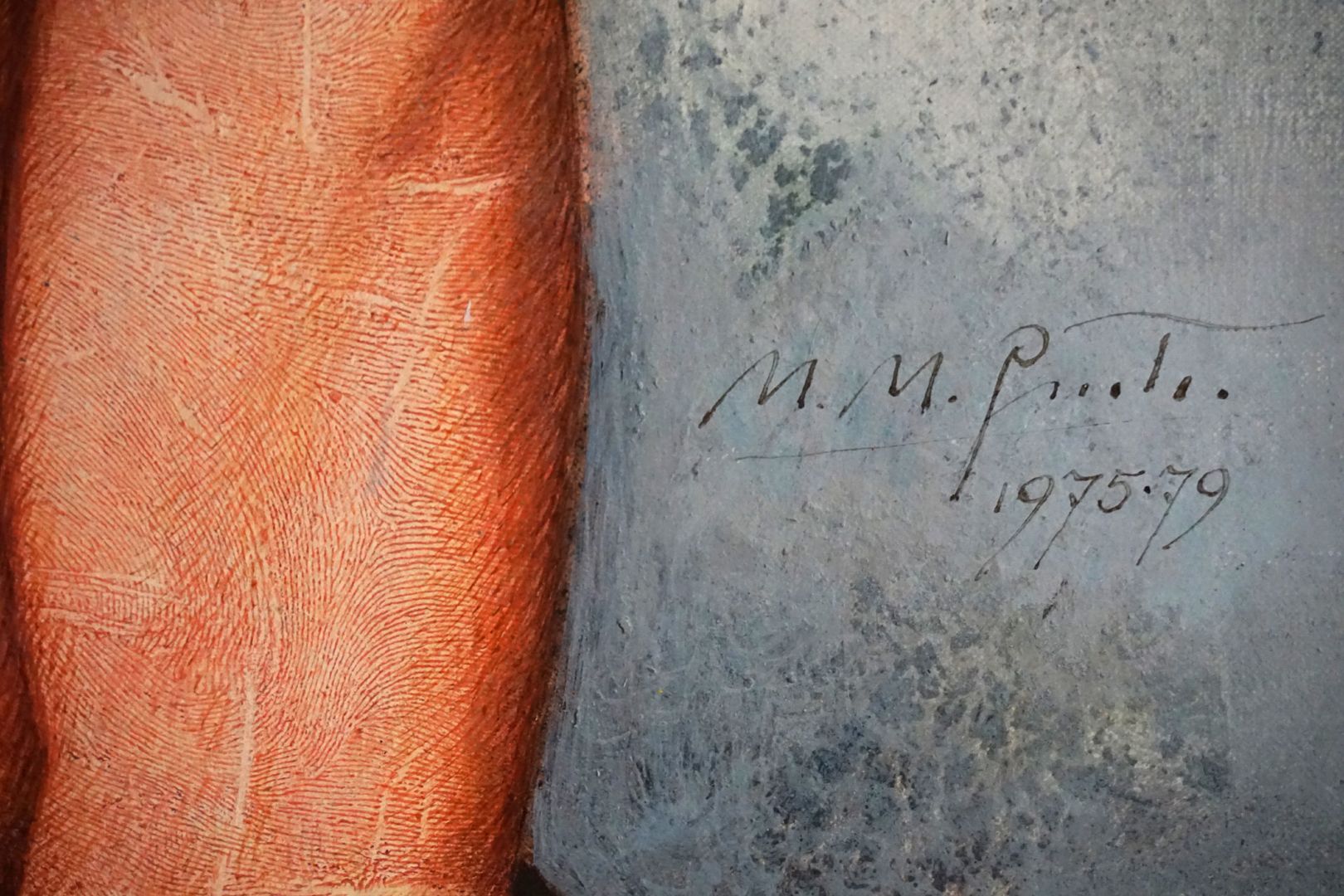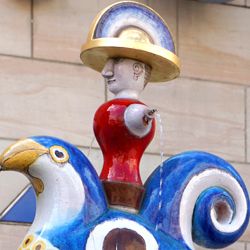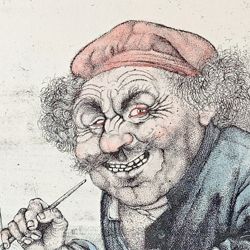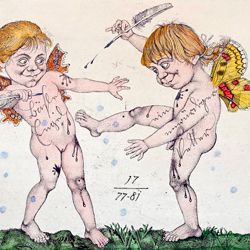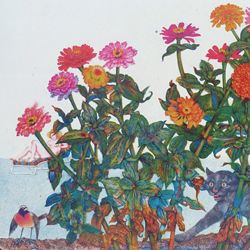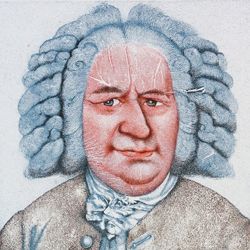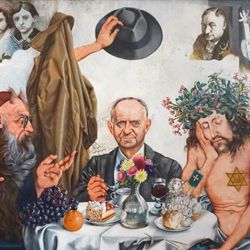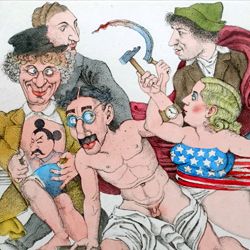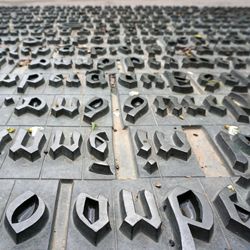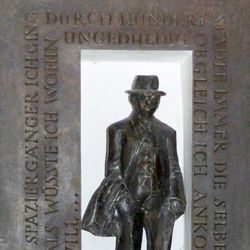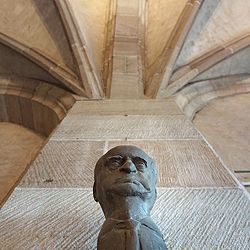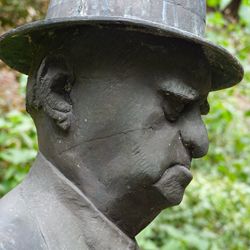Hermann Kesten in the Café
Hermann Kesten in the Café
1975 1979
Commissioned by the City of Nuremberg on the occasion of the 80th birthday of the honorary citizen Hermann Kesten.
________________________________
Persons depicted and visual references:
Upper left corner:
The father who died in the First World War (?) painted in the manner of Richard Lindner.
(Richard Lindner, painter, born in Hamburg in 1901, lived in Nuremberg from 1905, had to flee into exile from the National Socialists, as did Kesten).
Below his mother (?)
Depicted after childhood photos of Hermann Kesten and his sister Gina.
upper right corner:
Josef Roth:
Writer (*1894 in Brody, today Ukraine - † 1939 Paris), like Hermann Kesten also from Galicia.
Image excerpts from "Guernica" by Pablo Picasso.
Picture centre:
- Moses (in the pose of Moses by Michelangelo).
- Hermann Kesten
- Jesus (after "Christ as the Man of Sorrows" by Albrecht Dürer).
See also:
Christ as Man of Sorrows / painting by Dürer
________________________________
Prechtl in an interview (Medienwerkstatt Franken / Memories of Hermann Kesten 2017):
"We practically found the idea together in conversation. I assumed that I would paint Hermann Kesten in a café, analogous to his book "Dichter im Café". And you rarely sit alone in a café, so I asked him who he would like to have as a table companion. He didn't think twice and said - I don't know if he meant it seriously - "Between Jesus and Moses" and I took him at his word and put him in the picture.
________________________________
Michael Mathias Prechtl on his painting
(Westermann Monatshefte / November 11/1979 / p.208):
Hermann Kesten, the poet, sits in the imaginary coffee house of literature at the table between Moses and Jesus. So there are three Jews sitting together, three moralists, three writers, the emancipated between the Old and New Testaments. The seating arrangement of the world's child between figures of sacrosanct importance, perhaps perceived as presumptuous, seems to me to be entirely in the spirit of the assessors, according to which even the least should be given a place at the Lord's table.
Moses, the liberator and lawgiver, is still lecturing and explaining, his right hand resting on the bound tablets of the law and resting on the beard of the prophet in a Michelangelo gesture, blessing with his left hand, imploring his table companions. He wears work clothes, the blue blouse of the burden bearers - an active man, but he is old and almost blind.
Opposite him, Jesus, the passive sufferer, stripped bare, marked with the star as David's son, crowned with flowers and thorns, reads absorbedly in his present biography.
Hermann Kesten, the alert observer of our time, notices the viewer of the picture with an open gaze. The relationship of the three to each other is relationally unrelated. On the table, food and drink: in front of Moses the scouts, in front of Kesten, the passionate cake eater, the strawberry cake and the cup of coffee, in front of Jesus the Easter lamb, wine and bread. Visual references to Hermann Kesten's life and work are spread out on the background.
At the top left, a picture relic of his friend Richard Lindner "Hommage à Nuremberg" (Kesten and Lindner both grew up in Nuremberg) The picture, torn down, bears witness to the aggressive actions against art in our time, but also to the torn ties of both emigrants to this city and their homesickness for it.
The Lindner painting is covered on the right edge by a photograph depicting Hermann Kesten as a ten-year-old together with his sister. Next to it hangs an overcoat of the homeless traveller, from whose folds a helpful hand (of the muse?) guards the poet - or crowns him? Arranged towards the upper right corner, first the portrait of his friend Joseph Roth, with whom he was in Paris until the end and who now looks down on Hermann Kesten from above, and a piece from Picasso's Guernica, burnt, which is supposed to recall Kesten's book "The Children of Guernica". Other references to Kesten titles: The Twins of Nuremberg, Poet in a Café; references to his places of residence are given by the Michelangelo Moses (Rome), the Dürer Jesus (Nuremberg), the Roth portrait (Berlin 1932), the Lindner painting (made in New York in 1958, when both lived there).
A biographical picture, then, a character picture, a wishful picture at that, for the idea of painting him at the café table in the company of Moses and Jesus developed in conversation with Hermann Kesten during his visit to my studio a little more than four years ago, in the summer of 1975.
(I would like to thank Julia Riß, Amberg, for this reference)
________________________________
Lit:
- Hermann Kesten, Poet in a Café, 1959
- Michael Mathias Prechtl, Pictures and Drawings 1956 - 1981, Büchergilde 1981
- Hermann Kesten Living with People / A Nuremberg Reader / Anthology ars vivendi 1999
Location: Nuremberg, Altes Rathaus, Kleiner Ratssaal (property of the City of Nuremberg)
Design: Prechtl, Michael Mathias
Realization: Prechtl, Michael Mathias
Depicted: Kesten, Hermann
Material: acrylic on canvas
photo 2021, Theo Noll
Hermann Kesten in the Café
1975 1979
Commissioned by the City of Nuremberg on the occasion of the 80th birthday of the honorary citizen Hermann Kesten.
________________________________
Persons depicted and visual references:
Upper left corner:
The father who died in the First World War (?) painted in the manner of Richard Lindner.
(Richard Lindner, painter, born in Hamburg in 1901, lived in Nuremberg from 1905, had to flee into exile from the National Socialists, as did Kesten).
Below his mother (?)
Depicted after childhood photos of Hermann Kesten and his sister Gina.
upper right corner:
Josef Roth:
Writer (*1894 in Brody, today Ukraine - † 1939 Paris), like Hermann Kesten also from Galicia.
Image excerpts from "Guernica" by Pablo Picasso.
Picture centre:
- Moses (in the pose of Moses by Michelangelo).
- Hermann Kesten
- Jesus (after "Christ as the Man of Sorrows" by Albrecht Dürer).
See also:
Christ as Man of Sorrows / painting by Dürer
________________________________
Prechtl in an interview (Medienwerkstatt Franken / Memories of Hermann Kesten 2017):
"We practically found the idea together in conversation. I assumed that I would paint Hermann Kesten in a café, analogous to his book "Dichter im Café". And you rarely sit alone in a café, so I asked him who he would like to have as a table companion. He didn't think twice and said - I don't know if he meant it seriously - "Between Jesus and Moses" and I took him at his word and put him in the picture.
________________________________
Michael Mathias Prechtl on his painting
(Westermann Monatshefte / November 11/1979 / p.208):
Hermann Kesten, the poet, sits in the imaginary coffee house of literature at the table between Moses and Jesus. So there are three Jews sitting together, three moralists, three writers, the emancipated between the Old and New Testaments. The seating arrangement of the world's child between figures of sacrosanct importance, perhaps perceived as presumptuous, seems to me to be entirely in the spirit of the assessors, according to which even the least should be given a place at the Lord's table.
Moses, the liberator and lawgiver, is still lecturing and explaining, his right hand resting on the bound tablets of the law and resting on the beard of the prophet in a Michelangelo gesture, blessing with his left hand, imploring his table companions. He wears work clothes, the blue blouse of the burden bearers - an active man, but he is old and almost blind.
Opposite him, Jesus, the passive sufferer, stripped bare, marked with the star as David's son, crowned with flowers and thorns, reads absorbedly in his present biography.
Hermann Kesten, the alert observer of our time, notices the viewer of the picture with an open gaze. The relationship of the three to each other is relationally unrelated. On the table, food and drink: in front of Moses the scouts, in front of Kesten, the passionate cake eater, the strawberry cake and the cup of coffee, in front of Jesus the Easter lamb, wine and bread. Visual references to Hermann Kesten's life and work are spread out on the background.
At the top left, a picture relic of his friend Richard Lindner "Hommage à Nuremberg" (Kesten and Lindner both grew up in Nuremberg) The picture, torn down, bears witness to the aggressive actions against art in our time, but also to the torn ties of both emigrants to this city and their homesickness for it.
The Lindner painting is covered on the right edge by a photograph depicting Hermann Kesten as a ten-year-old together with his sister. Next to it hangs an overcoat of the homeless traveller, from whose folds a helpful hand (of the muse?) guards the poet - or crowns him? Arranged towards the upper right corner, first the portrait of his friend Joseph Roth, with whom he was in Paris until the end and who now looks down on Hermann Kesten from above, and a piece from Picasso's Guernica, burnt, which is supposed to recall Kesten's book "The Children of Guernica". Other references to Kesten titles: The Twins of Nuremberg, Poet in a Café; references to his places of residence are given by the Michelangelo Moses (Rome), the Dürer Jesus (Nuremberg), the Roth portrait (Berlin 1932), the Lindner painting (made in New York in 1958, when both lived there).
A biographical picture, then, a character picture, a wishful picture at that, for the idea of painting him at the café table in the company of Moses and Jesus developed in conversation with Hermann Kesten during his visit to my studio a little more than four years ago, in the summer of 1975.
(I would like to thank Julia Riß, Amberg, for this reference)
________________________________
Lit:
- Hermann Kesten, Poet in a Café, 1959
- Michael Mathias Prechtl, Pictures and Drawings 1956 - 1981, Büchergilde 1981
- Hermann Kesten Living with People / A Nuremberg Reader / Anthology ars vivendi 1999
Location: Nuremberg, Altes Rathaus, Kleiner Ratssaal (property of the City of Nuremberg)
Design: Prechtl, Michael Mathias
Realization: Prechtl, Michael Mathias
Depicted: Kesten, Hermann
Material: acrylic on canvas
photo 2021, Theo Noll
Hermann Kesten in the Café
1975 1979
Hermann Kesten in the centre
Commissioned by the City of Nuremberg on the occasion of the 80th birthday of the honorary citizen Hermann Kesten.
________________________________
Persons depicted and visual references:
Upper left corner:
The father who died in the First World War (?) painted in the manner of Richard Lindner.
(Richard Lindner, painter, born in Hamburg in 1901, lived in Nuremberg from 1905, had to flee into exile from the National Socialists, as did Kesten).
Below his mother (?)
Depicted after childhood photos of Hermann Kesten and his sister Gina.
upper right corner:
Josef Roth:
Writer (*1894 in Brody, today Ukraine - † 1939 Paris), like Hermann Kesten also from Galicia.
Image excerpts from "Guernica" by Pablo Picasso.
Picture centre:
- Moses (in the pose of Moses by Michelangelo).
- Hermann Kesten
- Jesus (after "Christ as the Man of Sorrows" by Albrecht Dürer).
See also:
Christ as Man of Sorrows / painting by Dürer
________________________________
Prechtl in an interview (Medienwerkstatt Franken / Memories of Hermann Kesten 2017):
"We practically found the idea together in conversation. I assumed that I would paint Hermann Kesten in a café, analogous to his book "Dichter im Café". And you rarely sit alone in a café, so I asked him who he would like to have as a table companion. He didn't think twice and said - I don't know if he meant it seriously - "Between Jesus and Moses" and I took him at his word and put him in the picture.
________________________________
Michael Mathias Prechtl on his painting
(Westermann Monatshefte / November 11/1979 / p.208):
Hermann Kesten, the poet, sits in the imaginary coffee house of literature at the table between Moses and Jesus. So there are three Jews sitting together, three moralists, three writers, the emancipated between the Old and New Testaments. The seating arrangement of the world's child between figures of sacrosanct importance, perhaps perceived as presumptuous, seems to me to be entirely in the spirit of the assessors, according to which even the least should be given a place at the Lord's table.
Moses, the liberator and lawgiver, is still lecturing and explaining, his right hand resting on the bound tablets of the law and resting on the beard of the prophet in a Michelangelo gesture, blessing with his left hand, imploring his table companions. He wears work clothes, the blue blouse of the burden bearers - an active man, but he is old and almost blind.
Opposite him, Jesus, the passive sufferer, stripped bare, marked with the star as David's son, crowned with flowers and thorns, reads absorbedly in his present biography.
Hermann Kesten, the alert observer of our time, notices the viewer of the picture with an open gaze. The relationship of the three to each other is relationally unrelated. On the table, food and drink: in front of Moses the scouts, in front of Kesten, the passionate cake eater, the strawberry cake and the cup of coffee, in front of Jesus the Easter lamb, wine and bread. Visual references to Hermann Kesten's life and work are spread out on the background.
At the top left, a picture relic of his friend Richard Lindner "Hommage à Nuremberg" (Kesten and Lindner both grew up in Nuremberg) The picture, torn down, bears witness to the aggressive actions against art in our time, but also to the torn ties of both emigrants to this city and their homesickness for it.
The Lindner painting is covered on the right edge by a photograph depicting Hermann Kesten as a ten-year-old together with his sister. Next to it hangs an overcoat of the homeless traveller, from whose folds a helpful hand (of the muse?) guards the poet - or crowns him? Arranged towards the upper right corner, first the portrait of his friend Joseph Roth, with whom he was in Paris until the end and who now looks down on Hermann Kesten from above, and a piece from Picasso's Guernica, burnt, which is supposed to recall Kesten's book "The Children of Guernica". Other references to Kesten titles: The Twins of Nuremberg, Poet in a Café; references to his places of residence are given by the Michelangelo Moses (Rome), the Dürer Jesus (Nuremberg), the Roth portrait (Berlin 1932), the Lindner painting (made in New York in 1958, when both lived there).
A biographical picture, then, a character picture, a wishful picture at that, for the idea of painting him at the café table in the company of Moses and Jesus developed in conversation with Hermann Kesten during his visit to my studio a little more than four years ago, in the summer of 1975.
(I would like to thank Julia Riß, Amberg, for this reference)
________________________________
Lit:
- Hermann Kesten, Poet in a Café, 1959
- Michael Mathias Prechtl, Pictures and Drawings 1956 - 1981, Büchergilde 1981
- Hermann Kesten Living with People / A Nuremberg Reader / Anthology ars vivendi 1999
Location: Nuremberg, Altes Rathaus, Kleiner Ratssaal (property of the City of Nuremberg)
Design: Prechtl, Michael Mathias
Realization: Prechtl, Michael Mathias
Depicted: Kesten, Hermann
Material: acrylic on canvas
photo 2021, Theo Noll
Hermann Kesten in the Café
1975 1979
upper left corner
Commissioned by the City of Nuremberg on the occasion of the 80th birthday of the honorary citizen Hermann Kesten.
________________________________
Persons depicted and visual references:
Upper left corner:
The father who died in the First World War (?) painted in the manner of Richard Lindner.
(Richard Lindner, painter, born in Hamburg in 1901, lived in Nuremberg from 1905, had to flee into exile from the National Socialists, as did Kesten).
Below his mother (?)
Depicted after childhood photos of Hermann Kesten and his sister Gina.
upper right corner:
Josef Roth:
Writer (*1894 in Brody, today Ukraine - † 1939 Paris), like Hermann Kesten also from Galicia.
Image excerpts from "Guernica" by Pablo Picasso.
Picture centre:
- Moses (in the pose of Moses by Michelangelo).
- Hermann Kesten
- Jesus (after "Christ as the Man of Sorrows" by Albrecht Dürer).
See also:
Christ as Man of Sorrows / painting by Dürer
________________________________
Prechtl in an interview (Medienwerkstatt Franken / Memories of Hermann Kesten 2017):
"We practically found the idea together in conversation. I assumed that I would paint Hermann Kesten in a café, analogous to his book "Dichter im Café". And you rarely sit alone in a café, so I asked him who he would like to have as a table companion. He didn't think twice and said - I don't know if he meant it seriously - "Between Jesus and Moses" and I took him at his word and put him in the picture.
________________________________
Michael Mathias Prechtl on his painting
(Westermann Monatshefte / November 11/1979 / p.208):
Hermann Kesten, the poet, sits in the imaginary coffee house of literature at the table between Moses and Jesus. So there are three Jews sitting together, three moralists, three writers, the emancipated between the Old and New Testaments. The seating arrangement of the world's child between figures of sacrosanct importance, perhaps perceived as presumptuous, seems to me to be entirely in the spirit of the assessors, according to which even the least should be given a place at the Lord's table.
Moses, the liberator and lawgiver, is still lecturing and explaining, his right hand resting on the bound tablets of the law and resting on the beard of the prophet in a Michelangelo gesture, blessing with his left hand, imploring his table companions. He wears work clothes, the blue blouse of the burden bearers - an active man, but he is old and almost blind.
Opposite him, Jesus, the passive sufferer, stripped bare, marked with the star as David's son, crowned with flowers and thorns, reads absorbedly in his present biography.
Hermann Kesten, the alert observer of our time, notices the viewer of the picture with an open gaze. The relationship of the three to each other is relationally unrelated. On the table, food and drink: in front of Moses the scouts, in front of Kesten, the passionate cake eater, the strawberry cake and the cup of coffee, in front of Jesus the Easter lamb, wine and bread. Visual references to Hermann Kesten's life and work are spread out on the background.
At the top left, a picture relic of his friend Richard Lindner "Hommage à Nuremberg" (Kesten and Lindner both grew up in Nuremberg) The picture, torn down, bears witness to the aggressive actions against art in our time, but also to the torn ties of both emigrants to this city and their homesickness for it.
The Lindner painting is covered on the right edge by a photograph depicting Hermann Kesten as a ten-year-old together with his sister. Next to it hangs an overcoat of the homeless traveller, from whose folds a helpful hand (of the muse?) guards the poet - or crowns him? Arranged towards the upper right corner, first the portrait of his friend Joseph Roth, with whom he was in Paris until the end and who now looks down on Hermann Kesten from above, and a piece from Picasso's Guernica, burnt, which is supposed to recall Kesten's book "The Children of Guernica". Other references to Kesten titles: The Twins of Nuremberg, Poet in a Café; references to his places of residence are given by the Michelangelo Moses (Rome), the Dürer Jesus (Nuremberg), the Roth portrait (Berlin 1932), the Lindner painting (made in New York in 1958, when both lived there).
A biographical picture, then, a character picture, a wishful picture at that, for the idea of painting him at the café table in the company of Moses and Jesus developed in conversation with Hermann Kesten during his visit to my studio a little more than four years ago, in the summer of 1975.
(I would like to thank Julia Riß, Amberg, for this reference)
________________________________
Lit:
- Hermann Kesten, Poet in a Café, 1959
- Michael Mathias Prechtl, Pictures and Drawings 1956 - 1981, Büchergilde 1981
- Hermann Kesten Living with People / A Nuremberg Reader / Anthology ars vivendi 1999
Location: Nuremberg, Altes Rathaus, Kleiner Ratssaal (property of the City of Nuremberg)
Design: Prechtl, Michael Mathias
Realization: Prechtl, Michael Mathias
Depicted: Kesten, Hermann
Material: acrylic on canvas
photo 2021, Theo Noll
Hermann Kesten in the Café
1975 1979
upper left corner and right: family photo Kesten Nuremberg 1910
Commissioned by the City of Nuremberg on the occasion of the 80th birthday of the honorary citizen Hermann Kesten.
________________________________
Persons depicted and visual references:
Upper left corner:
The father who died in the First World War (?) painted in the manner of Richard Lindner.
(Richard Lindner, painter, born in Hamburg in 1901, lived in Nuremberg from 1905, had to flee into exile from the National Socialists, as did Kesten).
Below his mother (?)
Depicted after childhood photos of Hermann Kesten and his sister Gina.
upper right corner:
Josef Roth:
Writer (*1894 in Brody, today Ukraine - † 1939 Paris), like Hermann Kesten also from Galicia.
Image excerpts from "Guernica" by Pablo Picasso.
Picture centre:
- Moses (in the pose of Moses by Michelangelo).
- Hermann Kesten
- Jesus (after "Christ as the Man of Sorrows" by Albrecht Dürer).
See also:
Christ as Man of Sorrows / painting by Dürer
________________________________
Prechtl in an interview (Medienwerkstatt Franken / Memories of Hermann Kesten 2017):
"We practically found the idea together in conversation. I assumed that I would paint Hermann Kesten in a café, analogous to his book "Dichter im Café". And you rarely sit alone in a café, so I asked him who he would like to have as a table companion. He didn't think twice and said - I don't know if he meant it seriously - "Between Jesus and Moses" and I took him at his word and put him in the picture.
________________________________
Michael Mathias Prechtl on his painting
(Westermann Monatshefte / November 11/1979 / p.208):
Hermann Kesten, the poet, sits in the imaginary coffee house of literature at the table between Moses and Jesus. So there are three Jews sitting together, three moralists, three writers, the emancipated between the Old and New Testaments. The seating arrangement of the world's child between figures of sacrosanct importance, perhaps perceived as presumptuous, seems to me to be entirely in the spirit of the assessors, according to which even the least should be given a place at the Lord's table.
Moses, the liberator and lawgiver, is still lecturing and explaining, his right hand resting on the bound tablets of the law and resting on the beard of the prophet in a Michelangelo gesture, blessing with his left hand, imploring his table companions. He wears work clothes, the blue blouse of the burden bearers - an active man, but he is old and almost blind.
Opposite him, Jesus, the passive sufferer, stripped bare, marked with the star as David's son, crowned with flowers and thorns, reads absorbedly in his present biography.
Hermann Kesten, the alert observer of our time, notices the viewer of the picture with an open gaze. The relationship of the three to each other is relationally unrelated. On the table, food and drink: in front of Moses the scouts, in front of Kesten, the passionate cake eater, the strawberry cake and the cup of coffee, in front of Jesus the Easter lamb, wine and bread. Visual references to Hermann Kesten's life and work are spread out on the background.
At the top left, a picture relic of his friend Richard Lindner "Hommage à Nuremberg" (Kesten and Lindner both grew up in Nuremberg) The picture, torn down, bears witness to the aggressive actions against art in our time, but also to the torn ties of both emigrants to this city and their homesickness for it.
The Lindner painting is covered on the right edge by a photograph depicting Hermann Kesten as a ten-year-old together with his sister. Next to it hangs an overcoat of the homeless traveller, from whose folds a helpful hand (of the muse?) guards the poet - or crowns him? Arranged towards the upper right corner, first the portrait of his friend Joseph Roth, with whom he was in Paris until the end and who now looks down on Hermann Kesten from above, and a piece from Picasso's Guernica, burnt, which is supposed to recall Kesten's book "The Children of Guernica". Other references to Kesten titles: The Twins of Nuremberg, Poet in a Café; references to his places of residence are given by the Michelangelo Moses (Rome), the Dürer Jesus (Nuremberg), the Roth portrait (Berlin 1932), the Lindner painting (made in New York in 1958, when both lived there).
A biographical picture, then, a character picture, a wishful picture at that, for the idea of painting him at the café table in the company of Moses and Jesus developed in conversation with Hermann Kesten during his visit to my studio a little more than four years ago, in the summer of 1975.
(I would like to thank Julia Riß, Amberg, for this reference)
________________________________
Lit:
- Hermann Kesten, Poet in a Café, 1959
- Michael Mathias Prechtl, Pictures and Drawings 1956 - 1981, Büchergilde 1981
- Hermann Kesten Living with People / A Nuremberg Reader / Anthology ars vivendi 1999
Location: Nuremberg, Altes Rathaus, Kleiner Ratssaal (property of the City of Nuremberg)
Design: Prechtl, Michael Mathias
Realization: Prechtl, Michael Mathias
Depicted: Kesten, Hermann
Material: acrylic on canvas
photo 2021, Theo Noll
Hermann Kesten in the Café
1975 1979
blue mark his favourite sister Gina / green mark Hermann Kesten
Commissioned by the City of Nuremberg on the occasion of the 80th birthday of the honorary citizen Hermann Kesten.
________________________________
Persons depicted and visual references:
Upper left corner:
The father who died in the First World War (?) painted in the manner of Richard Lindner.
(Richard Lindner, painter, born in Hamburg in 1901, lived in Nuremberg from 1905, had to flee into exile from the National Socialists, as did Kesten).
Below his mother (?)
Depicted after childhood photos of Hermann Kesten and his sister Gina.
upper right corner:
Josef Roth:
Writer (*1894 in Brody, today Ukraine - † 1939 Paris), like Hermann Kesten also from Galicia.
Image excerpts from "Guernica" by Pablo Picasso.
Picture centre:
- Moses (in the pose of Moses by Michelangelo).
- Hermann Kesten
- Jesus (after "Christ as the Man of Sorrows" by Albrecht Dürer).
See also:
Christ as Man of Sorrows / painting by Dürer
________________________________
Prechtl in an interview (Medienwerkstatt Franken / Memories of Hermann Kesten 2017):
"We practically found the idea together in conversation. I assumed that I would paint Hermann Kesten in a café, analogous to his book "Dichter im Café". And you rarely sit alone in a café, so I asked him who he would like to have as a table companion. He didn't think twice and said - I don't know if he meant it seriously - "Between Jesus and Moses" and I took him at his word and put him in the picture.
________________________________
Michael Mathias Prechtl on his painting
(Westermann Monatshefte / November 11/1979 / p.208):
Hermann Kesten, the poet, sits in the imaginary coffee house of literature at the table between Moses and Jesus. So there are three Jews sitting together, three moralists, three writers, the emancipated between the Old and New Testaments. The seating arrangement of the world's child between figures of sacrosanct importance, perhaps perceived as presumptuous, seems to me to be entirely in the spirit of the assessors, according to which even the least should be given a place at the Lord's table.
Moses, the liberator and lawgiver, is still lecturing and explaining, his right hand resting on the bound tablets of the law and resting on the beard of the prophet in a Michelangelo gesture, blessing with his left hand, imploring his table companions. He wears work clothes, the blue blouse of the burden bearers - an active man, but he is old and almost blind.
Opposite him, Jesus, the passive sufferer, stripped bare, marked with the star as David's son, crowned with flowers and thorns, reads absorbedly in his present biography.
Hermann Kesten, the alert observer of our time, notices the viewer of the picture with an open gaze. The relationship of the three to each other is relationally unrelated. On the table, food and drink: in front of Moses the scouts, in front of Kesten, the passionate cake eater, the strawberry cake and the cup of coffee, in front of Jesus the Easter lamb, wine and bread. Visual references to Hermann Kesten's life and work are spread out on the background.
At the top left, a picture relic of his friend Richard Lindner "Hommage à Nuremberg" (Kesten and Lindner both grew up in Nuremberg) The picture, torn down, bears witness to the aggressive actions against art in our time, but also to the torn ties of both emigrants to this city and their homesickness for it.
The Lindner painting is covered on the right edge by a photograph depicting Hermann Kesten as a ten-year-old together with his sister. Next to it hangs an overcoat of the homeless traveller, from whose folds a helpful hand (of the muse?) guards the poet - or crowns him? Arranged towards the upper right corner, first the portrait of his friend Joseph Roth, with whom he was in Paris until the end and who now looks down on Hermann Kesten from above, and a piece from Picasso's Guernica, burnt, which is supposed to recall Kesten's book "The Children of Guernica". Other references to Kesten titles: The Twins of Nuremberg, Poet in a Café; references to his places of residence are given by the Michelangelo Moses (Rome), the Dürer Jesus (Nuremberg), the Roth portrait (Berlin 1932), the Lindner painting (made in New York in 1958, when both lived there).
A biographical picture, then, a character picture, a wishful picture at that, for the idea of painting him at the café table in the company of Moses and Jesus developed in conversation with Hermann Kesten during his visit to my studio a little more than four years ago, in the summer of 1975.
(I would like to thank Julia Riß, Amberg, for this reference)
________________________________
Lit:
- Hermann Kesten, Poet in a Café, 1959
- Michael Mathias Prechtl, Pictures and Drawings 1956 - 1981, Büchergilde 1981
- Hermann Kesten Living with People / A Nuremberg Reader / Anthology ars vivendi 1999
Location: Nuremberg, Altes Rathaus, Kleiner Ratssaal (property of the City of Nuremberg)
Design: Prechtl, Michael Mathias
Realization: Prechtl, Michael Mathias
Depicted: Kesten, Hermann
Material: acrylic on canvas
photo 2021, Theo Noll
Hermann Kesten in the Café
1975 1979
The figure on the left, painted in the manner of Richard Lindner, could represent the father (?) of Hermann Kesten, who died in the First World War / on the right, as a comparison, a painting by Lindner: "Thank You" from 1971.
Commissioned by the City of Nuremberg on the occasion of the 80th birthday of the honorary citizen Hermann Kesten.
________________________________
Persons depicted and visual references:
Upper left corner:
The father who died in the First World War (?) painted in the manner of Richard Lindner.
(Richard Lindner, painter, born in Hamburg in 1901, lived in Nuremberg from 1905, had to flee into exile from the National Socialists, as did Kesten).
Below his mother (?)
Depicted after childhood photos of Hermann Kesten and his sister Gina.
upper right corner:
Josef Roth:
Writer (*1894 in Brody, today Ukraine - † 1939 Paris), like Hermann Kesten also from Galicia.
Image excerpts from "Guernica" by Pablo Picasso.
Picture centre:
- Moses (in the pose of Moses by Michelangelo).
- Hermann Kesten
- Jesus (after "Christ as the Man of Sorrows" by Albrecht Dürer).
See also:
Christ as Man of Sorrows / painting by Dürer
________________________________
Prechtl in an interview (Medienwerkstatt Franken / Memories of Hermann Kesten 2017):
"We practically found the idea together in conversation. I assumed that I would paint Hermann Kesten in a café, analogous to his book "Dichter im Café". And you rarely sit alone in a café, so I asked him who he would like to have as a table companion. He didn't think twice and said - I don't know if he meant it seriously - "Between Jesus and Moses" and I took him at his word and put him in the picture.
________________________________
Michael Mathias Prechtl on his painting
(Westermann Monatshefte / November 11/1979 / p.208):
Hermann Kesten, the poet, sits in the imaginary coffee house of literature at the table between Moses and Jesus. So there are three Jews sitting together, three moralists, three writers, the emancipated between the Old and New Testaments. The seating arrangement of the world's child between figures of sacrosanct importance, perhaps perceived as presumptuous, seems to me to be entirely in the spirit of the assessors, according to which even the least should be given a place at the Lord's table.
Moses, the liberator and lawgiver, is still lecturing and explaining, his right hand resting on the bound tablets of the law and resting on the beard of the prophet in a Michelangelo gesture, blessing with his left hand, imploring his table companions. He wears work clothes, the blue blouse of the burden bearers - an active man, but he is old and almost blind.
Opposite him, Jesus, the passive sufferer, stripped bare, marked with the star as David's son, crowned with flowers and thorns, reads absorbedly in his present biography.
Hermann Kesten, the alert observer of our time, notices the viewer of the picture with an open gaze. The relationship of the three to each other is relationally unrelated. On the table, food and drink: in front of Moses the scouts, in front of Kesten, the passionate cake eater, the strawberry cake and the cup of coffee, in front of Jesus the Easter lamb, wine and bread. Visual references to Hermann Kesten's life and work are spread out on the background.
At the top left, a picture relic of his friend Richard Lindner "Hommage à Nuremberg" (Kesten and Lindner both grew up in Nuremberg) The picture, torn down, bears witness to the aggressive actions against art in our time, but also to the torn ties of both emigrants to this city and their homesickness for it.
The Lindner painting is covered on the right edge by a photograph depicting Hermann Kesten as a ten-year-old together with his sister. Next to it hangs an overcoat of the homeless traveller, from whose folds a helpful hand (of the muse?) guards the poet - or crowns him? Arranged towards the upper right corner, first the portrait of his friend Joseph Roth, with whom he was in Paris until the end and who now looks down on Hermann Kesten from above, and a piece from Picasso's Guernica, burnt, which is supposed to recall Kesten's book "The Children of Guernica". Other references to Kesten titles: The Twins of Nuremberg, Poet in a Café; references to his places of residence are given by the Michelangelo Moses (Rome), the Dürer Jesus (Nuremberg), the Roth portrait (Berlin 1932), the Lindner painting (made in New York in 1958, when both lived there).
A biographical picture, then, a character picture, a wishful picture at that, for the idea of painting him at the café table in the company of Moses and Jesus developed in conversation with Hermann Kesten during his visit to my studio a little more than four years ago, in the summer of 1975.
(I would like to thank Julia Riß, Amberg, for this reference)
________________________________
Lit:
- Hermann Kesten, Poet in a Café, 1959
- Michael Mathias Prechtl, Pictures and Drawings 1956 - 1981, Büchergilde 1981
- Hermann Kesten Living with People / A Nuremberg Reader / Anthology ars vivendi 1999
Location: Nuremberg, Altes Rathaus, Kleiner Ratssaal (property of the City of Nuremberg)
Design: Prechtl, Michael Mathias
Realization: Prechtl, Michael Mathias
Depicted: Kesten, Hermann
Material: acrylic on canvas
photo 2021, Theo Noll
Hermann Kesten in the Café
1975 1979
upper half of the picture
photo 2021, Theo Noll
Commissioned by the City of Nuremberg on the occasion of the 80th birthday of the honorary citizen Hermann Kesten.
________________________________
Persons depicted and visual references:
Upper left corner:
The father who died in the First World War (?) painted in the manner of Richard Lindner.
(Richard Lindner, painter, born in Hamburg in 1901, lived in Nuremberg from 1905, had to flee into exile from the National Socialists, as did Kesten).
Below his mother (?)
Depicted after childhood photos of Hermann Kesten and his sister Gina.
upper right corner:
Josef Roth:
Writer (*1894 in Brody, today Ukraine - † 1939 Paris), like Hermann Kesten also from Galicia.
Image excerpts from "Guernica" by Pablo Picasso.
Picture centre:
- Moses (in the pose of Moses by Michelangelo).
- Hermann Kesten
- Jesus (after "Christ as the Man of Sorrows" by Albrecht Dürer).
See also:
Christ as Man of Sorrows / painting by Dürer
________________________________
Prechtl in an interview (Medienwerkstatt Franken / Memories of Hermann Kesten 2017):
"We practically found the idea together in conversation. I assumed that I would paint Hermann Kesten in a café, analogous to his book "Dichter im Café". And you rarely sit alone in a café, so I asked him who he would like to have as a table companion. He didn't think twice and said - I don't know if he meant it seriously - "Between Jesus and Moses" and I took him at his word and put him in the picture.
________________________________
Michael Mathias Prechtl on his painting
(Westermann Monatshefte / November 11/1979 / p.208):
Hermann Kesten, the poet, sits in the imaginary coffee house of literature at the table between Moses and Jesus. So there are three Jews sitting together, three moralists, three writers, the emancipated between the Old and New Testaments. The seating arrangement of the world's child between figures of sacrosanct importance, perhaps perceived as presumptuous, seems to me to be entirely in the spirit of the assessors, according to which even the least should be given a place at the Lord's table.
Moses, the liberator and lawgiver, is still lecturing and explaining, his right hand resting on the bound tablets of the law and resting on the beard of the prophet in a Michelangelo gesture, blessing with his left hand, imploring his table companions. He wears work clothes, the blue blouse of the burden bearers - an active man, but he is old and almost blind.
Opposite him, Jesus, the passive sufferer, stripped bare, marked with the star as David's son, crowned with flowers and thorns, reads absorbedly in his present biography.
Hermann Kesten, the alert observer of our time, notices the viewer of the picture with an open gaze. The relationship of the three to each other is relationally unrelated. On the table, food and drink: in front of Moses the scouts, in front of Kesten, the passionate cake eater, the strawberry cake and the cup of coffee, in front of Jesus the Easter lamb, wine and bread. Visual references to Hermann Kesten's life and work are spread out on the background.
At the top left, a picture relic of his friend Richard Lindner "Hommage à Nuremberg" (Kesten and Lindner both grew up in Nuremberg) The picture, torn down, bears witness to the aggressive actions against art in our time, but also to the torn ties of both emigrants to this city and their homesickness for it.
The Lindner painting is covered on the right edge by a photograph depicting Hermann Kesten as a ten-year-old together with his sister. Next to it hangs an overcoat of the homeless traveller, from whose folds a helpful hand (of the muse?) guards the poet - or crowns him? Arranged towards the upper right corner, first the portrait of his friend Joseph Roth, with whom he was in Paris until the end and who now looks down on Hermann Kesten from above, and a piece from Picasso's Guernica, burnt, which is supposed to recall Kesten's book "The Children of Guernica". Other references to Kesten titles: The Twins of Nuremberg, Poet in a Café; references to his places of residence are given by the Michelangelo Moses (Rome), the Dürer Jesus (Nuremberg), the Roth portrait (Berlin 1932), the Lindner painting (made in New York in 1958, when both lived there).
A biographical picture, then, a character picture, a wishful picture at that, for the idea of painting him at the café table in the company of Moses and Jesus developed in conversation with Hermann Kesten during his visit to my studio a little more than four years ago, in the summer of 1975.
(I would like to thank Julia Riß, Amberg, for this reference)
________________________________
Lit:
- Hermann Kesten, Poet in a Café, 1959
- Michael Mathias Prechtl, Pictures and Drawings 1956 - 1981, Büchergilde 1981
- Hermann Kesten Living with People / A Nuremberg Reader / Anthology ars vivendi 1999
Location: Nuremberg, Altes Rathaus, Kleiner Ratssaal (property of the City of Nuremberg)
Design: Prechtl, Michael Mathias
Realization: Prechtl, Michael Mathias
Depicted: Kesten, Hermann
Material: Acryl auf Leinwand
Hermann Kesten in the Café
1975 1979
upper right corner of the picture / Joseph Roth and a detail from "Guernica" by Picasso
Commissioned by the City of Nuremberg on the occasion of the 80th birthday of the honorary citizen Hermann Kesten.
________________________________
Persons depicted and visual references:
Upper left corner:
The father who died in the First World War (?) painted in the manner of Richard Lindner.
(Richard Lindner, painter, born in Hamburg in 1901, lived in Nuremberg from 1905, had to flee into exile from the National Socialists, as did Kesten).
Below his mother (?)
Depicted after childhood photos of Hermann Kesten and his sister Gina.
upper right corner:
Josef Roth:
Writer (*1894 in Brody, today Ukraine - † 1939 Paris), like Hermann Kesten also from Galicia.
Image excerpts from "Guernica" by Pablo Picasso.
Picture centre:
- Moses (in the pose of Moses by Michelangelo).
- Hermann Kesten
- Jesus (after "Christ as the Man of Sorrows" by Albrecht Dürer).
See also:
Christ as Man of Sorrows / painting by Dürer
________________________________
Prechtl in an interview (Medienwerkstatt Franken / Memories of Hermann Kesten 2017):
"We practically found the idea together in conversation. I assumed that I would paint Hermann Kesten in a café, analogous to his book "Dichter im Café". And you rarely sit alone in a café, so I asked him who he would like to have as a table companion. He didn't think twice and said - I don't know if he meant it seriously - "Between Jesus and Moses" and I took him at his word and put him in the picture.
________________________________
Michael Mathias Prechtl on his painting
(Westermann Monatshefte / November 11/1979 / p.208):
Hermann Kesten, the poet, sits in the imaginary coffee house of literature at the table between Moses and Jesus. So there are three Jews sitting together, three moralists, three writers, the emancipated between the Old and New Testaments. The seating arrangement of the world's child between figures of sacrosanct importance, perhaps perceived as presumptuous, seems to me to be entirely in the spirit of the assessors, according to which even the least should be given a place at the Lord's table.
Moses, the liberator and lawgiver, is still lecturing and explaining, his right hand resting on the bound tablets of the law and resting on the beard of the prophet in a Michelangelo gesture, blessing with his left hand, imploring his table companions. He wears work clothes, the blue blouse of the burden bearers - an active man, but he is old and almost blind.
Opposite him, Jesus, the passive sufferer, stripped bare, marked with the star as David's son, crowned with flowers and thorns, reads absorbedly in his present biography.
Hermann Kesten, the alert observer of our time, notices the viewer of the picture with an open gaze. The relationship of the three to each other is relationally unrelated. On the table, food and drink: in front of Moses the scouts, in front of Kesten, the passionate cake eater, the strawberry cake and the cup of coffee, in front of Jesus the Easter lamb, wine and bread. Visual references to Hermann Kesten's life and work are spread out on the background.
At the top left, a picture relic of his friend Richard Lindner "Hommage à Nuremberg" (Kesten and Lindner both grew up in Nuremberg) The picture, torn down, bears witness to the aggressive actions against art in our time, but also to the torn ties of both emigrants to this city and their homesickness for it.
The Lindner painting is covered on the right edge by a photograph depicting Hermann Kesten as a ten-year-old together with his sister. Next to it hangs an overcoat of the homeless traveller, from whose folds a helpful hand (of the muse?) guards the poet - or crowns him? Arranged towards the upper right corner, first the portrait of his friend Joseph Roth, with whom he was in Paris until the end and who now looks down on Hermann Kesten from above, and a piece from Picasso's Guernica, burnt, which is supposed to recall Kesten's book "The Children of Guernica". Other references to Kesten titles: The Twins of Nuremberg, Poet in a Café; references to his places of residence are given by the Michelangelo Moses (Rome), the Dürer Jesus (Nuremberg), the Roth portrait (Berlin 1932), the Lindner painting (made in New York in 1958, when both lived there).
A biographical picture, then, a character picture, a wishful picture at that, for the idea of painting him at the café table in the company of Moses and Jesus developed in conversation with Hermann Kesten during his visit to my studio a little more than four years ago, in the summer of 1975.
(I would like to thank Julia Riß, Amberg, for this reference)
________________________________
Lit:
- Hermann Kesten, Poet in a Café, 1959
- Michael Mathias Prechtl, Pictures and Drawings 1956 - 1981, Büchergilde 1981
- Hermann Kesten Living with People / A Nuremberg Reader / Anthology ars vivendi 1999
Location: Nuremberg, Altes Rathaus, Kleiner Ratssaal (property of the City of Nuremberg)
Design: Prechtl, Michael Mathias
Realization: Prechtl, Michael Mathias
Depicted: Kesten, Hermann
Material: acrylic on canvas
photo 2021, Theo Noll
Hermann Kesten in the Café
1975 1979
Comparison with Picasso's "Guernica" from 1937 (The Basque town of Guernika was destroyed in 1937 by an air raid of the German Condor Legion, a "training ground" of the German Luftwaffe and harbinger of the Second World War)
Commissioned by the City of Nuremberg on the occasion of the 80th birthday of the honorary citizen Hermann Kesten.
________________________________
Persons depicted and visual references:
Upper left corner:
The father who died in the First World War (?) painted in the manner of Richard Lindner.
(Richard Lindner, painter, born in Hamburg in 1901, lived in Nuremberg from 1905, had to flee into exile from the National Socialists, as did Kesten).
Below his mother (?)
Depicted after childhood photos of Hermann Kesten and his sister Gina.
upper right corner:
Josef Roth:
Writer (*1894 in Brody, today Ukraine - † 1939 Paris), like Hermann Kesten also from Galicia.
Image excerpts from "Guernica" by Pablo Picasso.
Picture centre:
- Moses (in the pose of Moses by Michelangelo).
- Hermann Kesten
- Jesus (after "Christ as the Man of Sorrows" by Albrecht Dürer).
See also:
Christ as Man of Sorrows / painting by Dürer
________________________________
Prechtl in an interview (Medienwerkstatt Franken / Memories of Hermann Kesten 2017):
"We practically found the idea together in conversation. I assumed that I would paint Hermann Kesten in a café, analogous to his book "Dichter im Café". And you rarely sit alone in a café, so I asked him who he would like to have as a table companion. He didn't think twice and said - I don't know if he meant it seriously - "Between Jesus and Moses" and I took him at his word and put him in the picture.
________________________________
Michael Mathias Prechtl on his painting
(Westermann Monatshefte / November 11/1979 / p.208):
Hermann Kesten, the poet, sits in the imaginary coffee house of literature at the table between Moses and Jesus. So there are three Jews sitting together, three moralists, three writers, the emancipated between the Old and New Testaments. The seating arrangement of the world's child between figures of sacrosanct importance, perhaps perceived as presumptuous, seems to me to be entirely in the spirit of the assessors, according to which even the least should be given a place at the Lord's table.
Moses, the liberator and lawgiver, is still lecturing and explaining, his right hand resting on the bound tablets of the law and resting on the beard of the prophet in a Michelangelo gesture, blessing with his left hand, imploring his table companions. He wears work clothes, the blue blouse of the burden bearers - an active man, but he is old and almost blind.
Opposite him, Jesus, the passive sufferer, stripped bare, marked with the star as David's son, crowned with flowers and thorns, reads absorbedly in his present biography.
Hermann Kesten, the alert observer of our time, notices the viewer of the picture with an open gaze. The relationship of the three to each other is relationally unrelated. On the table, food and drink: in front of Moses the scouts, in front of Kesten, the passionate cake eater, the strawberry cake and the cup of coffee, in front of Jesus the Easter lamb, wine and bread. Visual references to Hermann Kesten's life and work are spread out on the background.
At the top left, a picture relic of his friend Richard Lindner "Hommage à Nuremberg" (Kesten and Lindner both grew up in Nuremberg) The picture, torn down, bears witness to the aggressive actions against art in our time, but also to the torn ties of both emigrants to this city and their homesickness for it.
The Lindner painting is covered on the right edge by a photograph depicting Hermann Kesten as a ten-year-old together with his sister. Next to it hangs an overcoat of the homeless traveller, from whose folds a helpful hand (of the muse?) guards the poet - or crowns him? Arranged towards the upper right corner, first the portrait of his friend Joseph Roth, with whom he was in Paris until the end and who now looks down on Hermann Kesten from above, and a piece from Picasso's Guernica, burnt, which is supposed to recall Kesten's book "The Children of Guernica". Other references to Kesten titles: The Twins of Nuremberg, Poet in a Café; references to his places of residence are given by the Michelangelo Moses (Rome), the Dürer Jesus (Nuremberg), the Roth portrait (Berlin 1932), the Lindner painting (made in New York in 1958, when both lived there).
A biographical picture, then, a character picture, a wishful picture at that, for the idea of painting him at the café table in the company of Moses and Jesus developed in conversation with Hermann Kesten during his visit to my studio a little more than four years ago, in the summer of 1975.
(I would like to thank Julia Riß, Amberg, for this reference)
________________________________
Lit:
- Hermann Kesten, Poet in a Café, 1959
- Michael Mathias Prechtl, Pictures and Drawings 1956 - 1981, Büchergilde 1981
- Hermann Kesten Living with People / A Nuremberg Reader / Anthology ars vivendi 1999
Location: Nuremberg, Altes Rathaus, Kleiner Ratssaal (property of the City of Nuremberg)
Design: Prechtl, Michael Mathias
Realization: Prechtl, Michael Mathias
Depicted: Kesten, Hermann
Material: acrylic on canvas
photo 2021, Theo Noll
Hermann Kesten in the Café
1975 1979
Moses, sitting left of the table
Commissioned by the City of Nuremberg on the occasion of the 80th birthday of the honorary citizen Hermann Kesten.
________________________________
Persons depicted and visual references:
Upper left corner:
The father who died in the First World War (?) painted in the manner of Richard Lindner.
(Richard Lindner, painter, born in Hamburg in 1901, lived in Nuremberg from 1905, had to flee into exile from the National Socialists, as did Kesten).
Below his mother (?)
Depicted after childhood photos of Hermann Kesten and his sister Gina.
upper right corner:
Josef Roth:
Writer (*1894 in Brody, today Ukraine - † 1939 Paris), like Hermann Kesten also from Galicia.
Image excerpts from "Guernica" by Pablo Picasso.
Picture centre:
- Moses (in the pose of Moses by Michelangelo).
- Hermann Kesten
- Jesus (after "Christ as the Man of Sorrows" by Albrecht Dürer).
See also:
Christ as Man of Sorrows / painting by Dürer
________________________________
Prechtl in an interview (Medienwerkstatt Franken / Memories of Hermann Kesten 2017):
"We practically found the idea together in conversation. I assumed that I would paint Hermann Kesten in a café, analogous to his book "Dichter im Café". And you rarely sit alone in a café, so I asked him who he would like to have as a table companion. He didn't think twice and said - I don't know if he meant it seriously - "Between Jesus and Moses" and I took him at his word and put him in the picture.
________________________________
Michael Mathias Prechtl on his painting
(Westermann Monatshefte / November 11/1979 / p.208):
Hermann Kesten, the poet, sits in the imaginary coffee house of literature at the table between Moses and Jesus. So there are three Jews sitting together, three moralists, three writers, the emancipated between the Old and New Testaments. The seating arrangement of the world's child between figures of sacrosanct importance, perhaps perceived as presumptuous, seems to me to be entirely in the spirit of the assessors, according to which even the least should be given a place at the Lord's table.
Moses, the liberator and lawgiver, is still lecturing and explaining, his right hand resting on the bound tablets of the law and resting on the beard of the prophet in a Michelangelo gesture, blessing with his left hand, imploring his table companions. He wears work clothes, the blue blouse of the burden bearers - an active man, but he is old and almost blind.
Opposite him, Jesus, the passive sufferer, stripped bare, marked with the star as David's son, crowned with flowers and thorns, reads absorbedly in his present biography.
Hermann Kesten, the alert observer of our time, notices the viewer of the picture with an open gaze. The relationship of the three to each other is relationally unrelated. On the table, food and drink: in front of Moses the scouts, in front of Kesten, the passionate cake eater, the strawberry cake and the cup of coffee, in front of Jesus the Easter lamb, wine and bread. Visual references to Hermann Kesten's life and work are spread out on the background.
At the top left, a picture relic of his friend Richard Lindner "Hommage à Nuremberg" (Kesten and Lindner both grew up in Nuremberg) The picture, torn down, bears witness to the aggressive actions against art in our time, but also to the torn ties of both emigrants to this city and their homesickness for it.
The Lindner painting is covered on the right edge by a photograph depicting Hermann Kesten as a ten-year-old together with his sister. Next to it hangs an overcoat of the homeless traveller, from whose folds a helpful hand (of the muse?) guards the poet - or crowns him? Arranged towards the upper right corner, first the portrait of his friend Joseph Roth, with whom he was in Paris until the end and who now looks down on Hermann Kesten from above, and a piece from Picasso's Guernica, burnt, which is supposed to recall Kesten's book "The Children of Guernica". Other references to Kesten titles: The Twins of Nuremberg, Poet in a Café; references to his places of residence are given by the Michelangelo Moses (Rome), the Dürer Jesus (Nuremberg), the Roth portrait (Berlin 1932), the Lindner painting (made in New York in 1958, when both lived there).
A biographical picture, then, a character picture, a wishful picture at that, for the idea of painting him at the café table in the company of Moses and Jesus developed in conversation with Hermann Kesten during his visit to my studio a little more than four years ago, in the summer of 1975.
(I would like to thank Julia Riß, Amberg, for this reference)
________________________________
Lit:
- Hermann Kesten, Poet in a Café, 1959
- Michael Mathias Prechtl, Pictures and Drawings 1956 - 1981, Büchergilde 1981
- Hermann Kesten Living with People / A Nuremberg Reader / Anthology ars vivendi 1999
Location: Nuremberg, Altes Rathaus, Kleiner Ratssaal (property of the City of Nuremberg)
Design: Prechtl, Michael Mathias
Realization: Prechtl, Michael Mathias
Depicted: Kesten, Hermann
Material: acrylic on canvas
photo 2021, Theo Noll
Hermann Kesten in the Café
1975 1979
Moses, detail
Commissioned by the City of Nuremberg on the occasion of the 80th birthday of the honorary citizen Hermann Kesten.
________________________________
Persons depicted and visual references:
Upper left corner:
The father who died in the First World War (?) painted in the manner of Richard Lindner.
(Richard Lindner, painter, born in Hamburg in 1901, lived in Nuremberg from 1905, had to flee into exile from the National Socialists, as did Kesten).
Below his mother (?)
Depicted after childhood photos of Hermann Kesten and his sister Gina.
upper right corner:
Josef Roth:
Writer (*1894 in Brody, today Ukraine - † 1939 Paris), like Hermann Kesten also from Galicia.
Image excerpts from "Guernica" by Pablo Picasso.
Picture centre:
- Moses (in the pose of Moses by Michelangelo).
- Hermann Kesten
- Jesus (after "Christ as the Man of Sorrows" by Albrecht Dürer).
See also:
Christ as Man of Sorrows / painting by Dürer
________________________________
Prechtl in an interview (Medienwerkstatt Franken / Memories of Hermann Kesten 2017):
"We practically found the idea together in conversation. I assumed that I would paint Hermann Kesten in a café, analogous to his book "Dichter im Café". And you rarely sit alone in a café, so I asked him who he would like to have as a table companion. He didn't think twice and said - I don't know if he meant it seriously - "Between Jesus and Moses" and I took him at his word and put him in the picture.
________________________________
Michael Mathias Prechtl on his painting
(Westermann Monatshefte / November 11/1979 / p.208):
Hermann Kesten, the poet, sits in the imaginary coffee house of literature at the table between Moses and Jesus. So there are three Jews sitting together, three moralists, three writers, the emancipated between the Old and New Testaments. The seating arrangement of the world's child between figures of sacrosanct importance, perhaps perceived as presumptuous, seems to me to be entirely in the spirit of the assessors, according to which even the least should be given a place at the Lord's table.
Moses, the liberator and lawgiver, is still lecturing and explaining, his right hand resting on the bound tablets of the law and resting on the beard of the prophet in a Michelangelo gesture, blessing with his left hand, imploring his table companions. He wears work clothes, the blue blouse of the burden bearers - an active man, but he is old and almost blind.
Opposite him, Jesus, the passive sufferer, stripped bare, marked with the star as David's son, crowned with flowers and thorns, reads absorbedly in his present biography.
Hermann Kesten, the alert observer of our time, notices the viewer of the picture with an open gaze. The relationship of the three to each other is relationally unrelated. On the table, food and drink: in front of Moses the scouts, in front of Kesten, the passionate cake eater, the strawberry cake and the cup of coffee, in front of Jesus the Easter lamb, wine and bread. Visual references to Hermann Kesten's life and work are spread out on the background.
At the top left, a picture relic of his friend Richard Lindner "Hommage à Nuremberg" (Kesten and Lindner both grew up in Nuremberg) The picture, torn down, bears witness to the aggressive actions against art in our time, but also to the torn ties of both emigrants to this city and their homesickness for it.
The Lindner painting is covered on the right edge by a photograph depicting Hermann Kesten as a ten-year-old together with his sister. Next to it hangs an overcoat of the homeless traveller, from whose folds a helpful hand (of the muse?) guards the poet - or crowns him? Arranged towards the upper right corner, first the portrait of his friend Joseph Roth, with whom he was in Paris until the end and who now looks down on Hermann Kesten from above, and a piece from Picasso's Guernica, burnt, which is supposed to recall Kesten's book "The Children of Guernica". Other references to Kesten titles: The Twins of Nuremberg, Poet in a Café; references to his places of residence are given by the Michelangelo Moses (Rome), the Dürer Jesus (Nuremberg), the Roth portrait (Berlin 1932), the Lindner painting (made in New York in 1958, when both lived there).
A biographical picture, then, a character picture, a wishful picture at that, for the idea of painting him at the café table in the company of Moses and Jesus developed in conversation with Hermann Kesten during his visit to my studio a little more than four years ago, in the summer of 1975.
(I would like to thank Julia Riß, Amberg, for this reference)
________________________________
Lit:
- Hermann Kesten, Poet in a Café, 1959
- Michael Mathias Prechtl, Pictures and Drawings 1956 - 1981, Büchergilde 1981
- Hermann Kesten Living with People / A Nuremberg Reader / Anthology ars vivendi 1999
Location: Nuremberg, Altes Rathaus, Kleiner Ratssaal (property of the City of Nuremberg)
Design: Prechtl, Michael Mathias
Realization: Prechtl, Michael Mathias
Depicted: Kesten, Hermann
Material: acrylic on canvas
photo 2021, Theo Noll
Hermann Kesten in the Café
1975 1979
comparison with Michelangelo's depiction of Moses in Rome (San Pietro in Vincoli)
Commissioned by the City of Nuremberg on the occasion of the 80th birthday of the honorary citizen Hermann Kesten.
________________________________
Persons depicted and visual references:
Upper left corner:
The father who died in the First World War (?) painted in the manner of Richard Lindner.
(Richard Lindner, painter, born in Hamburg in 1901, lived in Nuremberg from 1905, had to flee into exile from the National Socialists, as did Kesten).
Below his mother (?)
Depicted after childhood photos of Hermann Kesten and his sister Gina.
upper right corner:
Josef Roth:
Writer (*1894 in Brody, today Ukraine - † 1939 Paris), like Hermann Kesten also from Galicia.
Image excerpts from "Guernica" by Pablo Picasso.
Picture centre:
- Moses (in the pose of Moses by Michelangelo).
- Hermann Kesten
- Jesus (after "Christ as the Man of Sorrows" by Albrecht Dürer).
See also:
Christ as Man of Sorrows / painting by Dürer
________________________________
Prechtl in an interview (Medienwerkstatt Franken / Memories of Hermann Kesten 2017):
"We practically found the idea together in conversation. I assumed that I would paint Hermann Kesten in a café, analogous to his book "Dichter im Café". And you rarely sit alone in a café, so I asked him who he would like to have as a table companion. He didn't think twice and said - I don't know if he meant it seriously - "Between Jesus and Moses" and I took him at his word and put him in the picture.
________________________________
Michael Mathias Prechtl on his painting
(Westermann Monatshefte / November 11/1979 / p.208):
Hermann Kesten, the poet, sits in the imaginary coffee house of literature at the table between Moses and Jesus. So there are three Jews sitting together, three moralists, three writers, the emancipated between the Old and New Testaments. The seating arrangement of the world's child between figures of sacrosanct importance, perhaps perceived as presumptuous, seems to me to be entirely in the spirit of the assessors, according to which even the least should be given a place at the Lord's table.
Moses, the liberator and lawgiver, is still lecturing and explaining, his right hand resting on the bound tablets of the law and resting on the beard of the prophet in a Michelangelo gesture, blessing with his left hand, imploring his table companions. He wears work clothes, the blue blouse of the burden bearers - an active man, but he is old and almost blind.
Opposite him, Jesus, the passive sufferer, stripped bare, marked with the star as David's son, crowned with flowers and thorns, reads absorbedly in his present biography.
Hermann Kesten, the alert observer of our time, notices the viewer of the picture with an open gaze. The relationship of the three to each other is relationally unrelated. On the table, food and drink: in front of Moses the scouts, in front of Kesten, the passionate cake eater, the strawberry cake and the cup of coffee, in front of Jesus the Easter lamb, wine and bread. Visual references to Hermann Kesten's life and work are spread out on the background.
At the top left, a picture relic of his friend Richard Lindner "Hommage à Nuremberg" (Kesten and Lindner both grew up in Nuremberg) The picture, torn down, bears witness to the aggressive actions against art in our time, but also to the torn ties of both emigrants to this city and their homesickness for it.
The Lindner painting is covered on the right edge by a photograph depicting Hermann Kesten as a ten-year-old together with his sister. Next to it hangs an overcoat of the homeless traveller, from whose folds a helpful hand (of the muse?) guards the poet - or crowns him? Arranged towards the upper right corner, first the portrait of his friend Joseph Roth, with whom he was in Paris until the end and who now looks down on Hermann Kesten from above, and a piece from Picasso's Guernica, burnt, which is supposed to recall Kesten's book "The Children of Guernica". Other references to Kesten titles: The Twins of Nuremberg, Poet in a Café; references to his places of residence are given by the Michelangelo Moses (Rome), the Dürer Jesus (Nuremberg), the Roth portrait (Berlin 1932), the Lindner painting (made in New York in 1958, when both lived there).
A biographical picture, then, a character picture, a wishful picture at that, for the idea of painting him at the café table in the company of Moses and Jesus developed in conversation with Hermann Kesten during his visit to my studio a little more than four years ago, in the summer of 1975.
(I would like to thank Julia Riß, Amberg, for this reference)
________________________________
Lit:
- Hermann Kesten, Poet in a Café, 1959
- Michael Mathias Prechtl, Pictures and Drawings 1956 - 1981, Büchergilde 1981
- Hermann Kesten Living with People / A Nuremberg Reader / Anthology ars vivendi 1999
Location: Nuremberg, Altes Rathaus, Kleiner Ratssaal (property of the City of Nuremberg)
Design: Prechtl, Michael Mathias
Realization: Prechtl, Michael Mathias
Depicted: Kesten, Hermann
Material: acrylic on canvas
photo 2013 / 2021, Pablo de la Riestra, Theo Noll
Hermann Kesten in the Café
1975 1979
Moses, detail with his left hand
Commissioned by the City of Nuremberg on the occasion of the 80th birthday of the honorary citizen Hermann Kesten.
________________________________
Persons depicted and visual references:
Upper left corner:
The father who died in the First World War (?) painted in the manner of Richard Lindner.
(Richard Lindner, painter, born in Hamburg in 1901, lived in Nuremberg from 1905, had to flee into exile from the National Socialists, as did Kesten).
Below his mother (?)
Depicted after childhood photos of Hermann Kesten and his sister Gina.
upper right corner:
Josef Roth:
Writer (*1894 in Brody, today Ukraine - † 1939 Paris), like Hermann Kesten also from Galicia.
Image excerpts from "Guernica" by Pablo Picasso.
Picture centre:
- Moses (in the pose of Moses by Michelangelo).
- Hermann Kesten
- Jesus (after "Christ as the Man of Sorrows" by Albrecht Dürer).
See also:
Christ as Man of Sorrows / painting by Dürer
________________________________
Prechtl in an interview (Medienwerkstatt Franken / Memories of Hermann Kesten 2017):
"We practically found the idea together in conversation. I assumed that I would paint Hermann Kesten in a café, analogous to his book "Dichter im Café". And you rarely sit alone in a café, so I asked him who he would like to have as a table companion. He didn't think twice and said - I don't know if he meant it seriously - "Between Jesus and Moses" and I took him at his word and put him in the picture.
________________________________
Michael Mathias Prechtl on his painting
(Westermann Monatshefte / November 11/1979 / p.208):
Hermann Kesten, the poet, sits in the imaginary coffee house of literature at the table between Moses and Jesus. So there are three Jews sitting together, three moralists, three writers, the emancipated between the Old and New Testaments. The seating arrangement of the world's child between figures of sacrosanct importance, perhaps perceived as presumptuous, seems to me to be entirely in the spirit of the assessors, according to which even the least should be given a place at the Lord's table.
Moses, the liberator and lawgiver, is still lecturing and explaining, his right hand resting on the bound tablets of the law and resting on the beard of the prophet in a Michelangelo gesture, blessing with his left hand, imploring his table companions. He wears work clothes, the blue blouse of the burden bearers - an active man, but he is old and almost blind.
Opposite him, Jesus, the passive sufferer, stripped bare, marked with the star as David's son, crowned with flowers and thorns, reads absorbedly in his present biography.
Hermann Kesten, the alert observer of our time, notices the viewer of the picture with an open gaze. The relationship of the three to each other is relationally unrelated. On the table, food and drink: in front of Moses the scouts, in front of Kesten, the passionate cake eater, the strawberry cake and the cup of coffee, in front of Jesus the Easter lamb, wine and bread. Visual references to Hermann Kesten's life and work are spread out on the background.
At the top left, a picture relic of his friend Richard Lindner "Hommage à Nuremberg" (Kesten and Lindner both grew up in Nuremberg) The picture, torn down, bears witness to the aggressive actions against art in our time, but also to the torn ties of both emigrants to this city and their homesickness for it.
The Lindner painting is covered on the right edge by a photograph depicting Hermann Kesten as a ten-year-old together with his sister. Next to it hangs an overcoat of the homeless traveller, from whose folds a helpful hand (of the muse?) guards the poet - or crowns him? Arranged towards the upper right corner, first the portrait of his friend Joseph Roth, with whom he was in Paris until the end and who now looks down on Hermann Kesten from above, and a piece from Picasso's Guernica, burnt, which is supposed to recall Kesten's book "The Children of Guernica". Other references to Kesten titles: The Twins of Nuremberg, Poet in a Café; references to his places of residence are given by the Michelangelo Moses (Rome), the Dürer Jesus (Nuremberg), the Roth portrait (Berlin 1932), the Lindner painting (made in New York in 1958, when both lived there).
A biographical picture, then, a character picture, a wishful picture at that, for the idea of painting him at the café table in the company of Moses and Jesus developed in conversation with Hermann Kesten during his visit to my studio a little more than four years ago, in the summer of 1975.
(I would like to thank Julia Riß, Amberg, for this reference)
________________________________
Lit:
- Hermann Kesten, Poet in a Café, 1959
- Michael Mathias Prechtl, Pictures and Drawings 1956 - 1981, Büchergilde 1981
- Hermann Kesten Living with People / A Nuremberg Reader / Anthology ars vivendi 1999
Location: Nuremberg, Altes Rathaus, Kleiner Ratssaal (property of the City of Nuremberg)
Design: Prechtl, Michael Mathias
Realization: Prechtl, Michael Mathias
Depicted: Kesten, Hermann
Material: acrylic on canvas
photo 2021, Theo Noll
Hermann Kesten in the Café
1975 1979
Moses, detail with his right hand
Commissioned by the City of Nuremberg on the occasion of the 80th birthday of the honorary citizen Hermann Kesten.
________________________________
Persons depicted and visual references:
Upper left corner:
The father who died in the First World War (?) painted in the manner of Richard Lindner.
(Richard Lindner, painter, born in Hamburg in 1901, lived in Nuremberg from 1905, had to flee into exile from the National Socialists, as did Kesten).
Below his mother (?)
Depicted after childhood photos of Hermann Kesten and his sister Gina.
upper right corner:
Josef Roth:
Writer (*1894 in Brody, today Ukraine - † 1939 Paris), like Hermann Kesten also from Galicia.
Image excerpts from "Guernica" by Pablo Picasso.
Picture centre:
- Moses (in the pose of Moses by Michelangelo).
- Hermann Kesten
- Jesus (after "Christ as the Man of Sorrows" by Albrecht Dürer).
See also:
Christ as Man of Sorrows / painting by Dürer
________________________________
Prechtl in an interview (Medienwerkstatt Franken / Memories of Hermann Kesten 2017):
"We practically found the idea together in conversation. I assumed that I would paint Hermann Kesten in a café, analogous to his book "Dichter im Café". And you rarely sit alone in a café, so I asked him who he would like to have as a table companion. He didn't think twice and said - I don't know if he meant it seriously - "Between Jesus and Moses" and I took him at his word and put him in the picture.
________________________________
Michael Mathias Prechtl on his painting
(Westermann Monatshefte / November 11/1979 / p.208):
Hermann Kesten, the poet, sits in the imaginary coffee house of literature at the table between Moses and Jesus. So there are three Jews sitting together, three moralists, three writers, the emancipated between the Old and New Testaments. The seating arrangement of the world's child between figures of sacrosanct importance, perhaps perceived as presumptuous, seems to me to be entirely in the spirit of the assessors, according to which even the least should be given a place at the Lord's table.
Moses, the liberator and lawgiver, is still lecturing and explaining, his right hand resting on the bound tablets of the law and resting on the beard of the prophet in a Michelangelo gesture, blessing with his left hand, imploring his table companions. He wears work clothes, the blue blouse of the burden bearers - an active man, but he is old and almost blind.
Opposite him, Jesus, the passive sufferer, stripped bare, marked with the star as David's son, crowned with flowers and thorns, reads absorbedly in his present biography.
Hermann Kesten, the alert observer of our time, notices the viewer of the picture with an open gaze. The relationship of the three to each other is relationally unrelated. On the table, food and drink: in front of Moses the scouts, in front of Kesten, the passionate cake eater, the strawberry cake and the cup of coffee, in front of Jesus the Easter lamb, wine and bread. Visual references to Hermann Kesten's life and work are spread out on the background.
At the top left, a picture relic of his friend Richard Lindner "Hommage à Nuremberg" (Kesten and Lindner both grew up in Nuremberg) The picture, torn down, bears witness to the aggressive actions against art in our time, but also to the torn ties of both emigrants to this city and their homesickness for it.
The Lindner painting is covered on the right edge by a photograph depicting Hermann Kesten as a ten-year-old together with his sister. Next to it hangs an overcoat of the homeless traveller, from whose folds a helpful hand (of the muse?) guards the poet - or crowns him? Arranged towards the upper right corner, first the portrait of his friend Joseph Roth, with whom he was in Paris until the end and who now looks down on Hermann Kesten from above, and a piece from Picasso's Guernica, burnt, which is supposed to recall Kesten's book "The Children of Guernica". Other references to Kesten titles: The Twins of Nuremberg, Poet in a Café; references to his places of residence are given by the Michelangelo Moses (Rome), the Dürer Jesus (Nuremberg), the Roth portrait (Berlin 1932), the Lindner painting (made in New York in 1958, when both lived there).
A biographical picture, then, a character picture, a wishful picture at that, for the idea of painting him at the café table in the company of Moses and Jesus developed in conversation with Hermann Kesten during his visit to my studio a little more than four years ago, in the summer of 1975.
(I would like to thank Julia Riß, Amberg, for this reference)
________________________________
Lit:
- Hermann Kesten, Poet in a Café, 1959
- Michael Mathias Prechtl, Pictures and Drawings 1956 - 1981, Büchergilde 1981
- Hermann Kesten Living with People / A Nuremberg Reader / Anthology ars vivendi 1999
Location: Nuremberg, Altes Rathaus, Kleiner Ratssaal (property of the City of Nuremberg)
Design: Prechtl, Michael Mathias
Realization: Prechtl, Michael Mathias
Depicted: Kesten, Hermann
Material: acrylic on canvas
photo 2021, Theo Noll
Hermann Kesten in the Café
1975 1979
Hermann Kesten in the centre of the picture: "Next to it hangs the overcoat of the unhappy traveller" (after Prechtl).
Commissioned by the City of Nuremberg on the occasion of the 80th birthday of the honorary citizen Hermann Kesten.
________________________________
Persons depicted and visual references:
Upper left corner:
The father who died in the First World War (?) painted in the manner of Richard Lindner.
(Richard Lindner, painter, born in Hamburg in 1901, lived in Nuremberg from 1905, had to flee into exile from the National Socialists, as did Kesten).
Below his mother (?)
Depicted after childhood photos of Hermann Kesten and his sister Gina.
upper right corner:
Josef Roth:
Writer (*1894 in Brody, today Ukraine - † 1939 Paris), like Hermann Kesten also from Galicia.
Image excerpts from "Guernica" by Pablo Picasso.
Picture centre:
- Moses (in the pose of Moses by Michelangelo).
- Hermann Kesten
- Jesus (after "Christ as the Man of Sorrows" by Albrecht Dürer).
See also:
Christ as Man of Sorrows / painting by Dürer
________________________________
Prechtl in an interview (Medienwerkstatt Franken / Memories of Hermann Kesten 2017):
"We practically found the idea together in conversation. I assumed that I would paint Hermann Kesten in a café, analogous to his book "Dichter im Café". And you rarely sit alone in a café, so I asked him who he would like to have as a table companion. He didn't think twice and said - I don't know if he meant it seriously - "Between Jesus and Moses" and I took him at his word and put him in the picture.
________________________________
Michael Mathias Prechtl on his painting
(Westermann Monatshefte / November 11/1979 / p.208):
Hermann Kesten, the poet, sits in the imaginary coffee house of literature at the table between Moses and Jesus. So there are three Jews sitting together, three moralists, three writers, the emancipated between the Old and New Testaments. The seating arrangement of the world's child between figures of sacrosanct importance, perhaps perceived as presumptuous, seems to me to be entirely in the spirit of the assessors, according to which even the least should be given a place at the Lord's table.
Moses, the liberator and lawgiver, is still lecturing and explaining, his right hand resting on the bound tablets of the law and resting on the beard of the prophet in a Michelangelo gesture, blessing with his left hand, imploring his table companions. He wears work clothes, the blue blouse of the burden bearers - an active man, but he is old and almost blind.
Opposite him, Jesus, the passive sufferer, stripped bare, marked with the star as David's son, crowned with flowers and thorns, reads absorbedly in his present biography.
Hermann Kesten, the alert observer of our time, notices the viewer of the picture with an open gaze. The relationship of the three to each other is relationally unrelated. On the table, food and drink: in front of Moses the scouts, in front of Kesten, the passionate cake eater, the strawberry cake and the cup of coffee, in front of Jesus the Easter lamb, wine and bread. Visual references to Hermann Kesten's life and work are spread out on the background.
At the top left, a picture relic of his friend Richard Lindner "Hommage à Nuremberg" (Kesten and Lindner both grew up in Nuremberg) The picture, torn down, bears witness to the aggressive actions against art in our time, but also to the torn ties of both emigrants to this city and their homesickness for it.
The Lindner painting is covered on the right edge by a photograph depicting Hermann Kesten as a ten-year-old together with his sister. Next to it hangs an overcoat of the homeless traveller, from whose folds a helpful hand (of the muse?) guards the poet - or crowns him? Arranged towards the upper right corner, first the portrait of his friend Joseph Roth, with whom he was in Paris until the end and who now looks down on Hermann Kesten from above, and a piece from Picasso's Guernica, burnt, which is supposed to recall Kesten's book "The Children of Guernica". Other references to Kesten titles: The Twins of Nuremberg, Poet in a Café; references to his places of residence are given by the Michelangelo Moses (Rome), the Dürer Jesus (Nuremberg), the Roth portrait (Berlin 1932), the Lindner painting (made in New York in 1958, when both lived there).
A biographical picture, then, a character picture, a wishful picture at that, for the idea of painting him at the café table in the company of Moses and Jesus developed in conversation with Hermann Kesten during his visit to my studio a little more than four years ago, in the summer of 1975.
(I would like to thank Julia Riß, Amberg, for this reference)
________________________________
Lit:
- Hermann Kesten, Poet in a Café, 1959
- Michael Mathias Prechtl, Pictures and Drawings 1956 - 1981, Büchergilde 1981
- Hermann Kesten Living with People / A Nuremberg Reader / Anthology ars vivendi 1999
Location: Nuremberg, Altes Rathaus, Kleiner Ratssaal (property of the City of Nuremberg)
Design: Prechtl, Michael Mathias
Realization: Prechtl, Michael Mathias
Depicted: Kesten, Hermann
Material: acrylic on canvas
photo 2021, Theo Noll
Hermann Kesten in the Café
1975 1979
Detail with hat
Commissioned by the City of Nuremberg on the occasion of the 80th birthday of the honorary citizen Hermann Kesten.
________________________________
Persons depicted and visual references:
Upper left corner:
The father who died in the First World War (?) painted in the manner of Richard Lindner.
(Richard Lindner, painter, born in Hamburg in 1901, lived in Nuremberg from 1905, had to flee into exile from the National Socialists, as did Kesten).
Below his mother (?)
Depicted after childhood photos of Hermann Kesten and his sister Gina.
upper right corner:
Josef Roth:
Writer (*1894 in Brody, today Ukraine - † 1939 Paris), like Hermann Kesten also from Galicia.
Image excerpts from "Guernica" by Pablo Picasso.
Picture centre:
- Moses (in the pose of Moses by Michelangelo).
- Hermann Kesten
- Jesus (after "Christ as the Man of Sorrows" by Albrecht Dürer).
See also:
Christ as Man of Sorrows / painting by Dürer
________________________________
Prechtl in an interview (Medienwerkstatt Franken / Memories of Hermann Kesten 2017):
"We practically found the idea together in conversation. I assumed that I would paint Hermann Kesten in a café, analogous to his book "Dichter im Café". And you rarely sit alone in a café, so I asked him who he would like to have as a table companion. He didn't think twice and said - I don't know if he meant it seriously - "Between Jesus and Moses" and I took him at his word and put him in the picture.
________________________________
Michael Mathias Prechtl on his painting
(Westermann Monatshefte / November 11/1979 / p.208):
Hermann Kesten, the poet, sits in the imaginary coffee house of literature at the table between Moses and Jesus. So there are three Jews sitting together, three moralists, three writers, the emancipated between the Old and New Testaments. The seating arrangement of the world's child between figures of sacrosanct importance, perhaps perceived as presumptuous, seems to me to be entirely in the spirit of the assessors, according to which even the least should be given a place at the Lord's table.
Moses, the liberator and lawgiver, is still lecturing and explaining, his right hand resting on the bound tablets of the law and resting on the beard of the prophet in a Michelangelo gesture, blessing with his left hand, imploring his table companions. He wears work clothes, the blue blouse of the burden bearers - an active man, but he is old and almost blind.
Opposite him, Jesus, the passive sufferer, stripped bare, marked with the star as David's son, crowned with flowers and thorns, reads absorbedly in his present biography.
Hermann Kesten, the alert observer of our time, notices the viewer of the picture with an open gaze. The relationship of the three to each other is relationally unrelated. On the table, food and drink: in front of Moses the scouts, in front of Kesten, the passionate cake eater, the strawberry cake and the cup of coffee, in front of Jesus the Easter lamb, wine and bread. Visual references to Hermann Kesten's life and work are spread out on the background.
At the top left, a picture relic of his friend Richard Lindner "Hommage à Nuremberg" (Kesten and Lindner both grew up in Nuremberg) The picture, torn down, bears witness to the aggressive actions against art in our time, but also to the torn ties of both emigrants to this city and their homesickness for it.
The Lindner painting is covered on the right edge by a photograph depicting Hermann Kesten as a ten-year-old together with his sister. Next to it hangs an overcoat of the homeless traveller, from whose folds a helpful hand (of the muse?) guards the poet - or crowns him? Arranged towards the upper right corner, first the portrait of his friend Joseph Roth, with whom he was in Paris until the end and who now looks down on Hermann Kesten from above, and a piece from Picasso's Guernica, burnt, which is supposed to recall Kesten's book "The Children of Guernica". Other references to Kesten titles: The Twins of Nuremberg, Poet in a Café; references to his places of residence are given by the Michelangelo Moses (Rome), the Dürer Jesus (Nuremberg), the Roth portrait (Berlin 1932), the Lindner painting (made in New York in 1958, when both lived there).
A biographical picture, then, a character picture, a wishful picture at that, for the idea of painting him at the café table in the company of Moses and Jesus developed in conversation with Hermann Kesten during his visit to my studio a little more than four years ago, in the summer of 1975.
(I would like to thank Julia Riß, Amberg, for this reference)
________________________________
Lit:
- Hermann Kesten, Poet in a Café, 1959
- Michael Mathias Prechtl, Pictures and Drawings 1956 - 1981, Büchergilde 1981
- Hermann Kesten Living with People / A Nuremberg Reader / Anthology ars vivendi 1999
Location: Nuremberg, Altes Rathaus, Kleiner Ratssaal (property of the City of Nuremberg)
Design: Prechtl, Michael Mathias
Realization: Prechtl, Michael Mathias
Depicted: Kesten, Hermann
Material: acrylic on canvas
photo 2021, Theo Noll
Hermann Kesten in the Café
1975 1979
The hat over Kesten that protects the poet - or crowns him ? / Here, as a comparison, the crowning of the Virgin by Kraft from the epitaph of Hans Rebeck in the Frauenkirchefétisch.
Commissioned by the City of Nuremberg on the occasion of the 80th birthday of the honorary citizen Hermann Kesten.
________________________________
Persons depicted and visual references:
Upper left corner:
The father who died in the First World War (?) painted in the manner of Richard Lindner.
(Richard Lindner, painter, born in Hamburg in 1901, lived in Nuremberg from 1905, had to flee into exile from the National Socialists, as did Kesten).
Below his mother (?)
Depicted after childhood photos of Hermann Kesten and his sister Gina.
upper right corner:
Josef Roth:
Writer (*1894 in Brody, today Ukraine - † 1939 Paris), like Hermann Kesten also from Galicia.
Image excerpts from "Guernica" by Pablo Picasso.
Picture centre:
- Moses (in the pose of Moses by Michelangelo).
- Hermann Kesten
- Jesus (after "Christ as the Man of Sorrows" by Albrecht Dürer).
See also:
Christ as Man of Sorrows / painting by Dürer
________________________________
Prechtl in an interview (Medienwerkstatt Franken / Memories of Hermann Kesten 2017):
"We practically found the idea together in conversation. I assumed that I would paint Hermann Kesten in a café, analogous to his book "Dichter im Café". And you rarely sit alone in a café, so I asked him who he would like to have as a table companion. He didn't think twice and said - I don't know if he meant it seriously - "Between Jesus and Moses" and I took him at his word and put him in the picture.
________________________________
Michael Mathias Prechtl on his painting
(Westermann Monatshefte / November 11/1979 / p.208):
Hermann Kesten, the poet, sits in the imaginary coffee house of literature at the table between Moses and Jesus. So there are three Jews sitting together, three moralists, three writers, the emancipated between the Old and New Testaments. The seating arrangement of the world's child between figures of sacrosanct importance, perhaps perceived as presumptuous, seems to me to be entirely in the spirit of the assessors, according to which even the least should be given a place at the Lord's table.
Moses, the liberator and lawgiver, is still lecturing and explaining, his right hand resting on the bound tablets of the law and resting on the beard of the prophet in a Michelangelo gesture, blessing with his left hand, imploring his table companions. He wears work clothes, the blue blouse of the burden bearers - an active man, but he is old and almost blind.
Opposite him, Jesus, the passive sufferer, stripped bare, marked with the star as David's son, crowned with flowers and thorns, reads absorbedly in his present biography.
Hermann Kesten, the alert observer of our time, notices the viewer of the picture with an open gaze. The relationship of the three to each other is relationally unrelated. On the table, food and drink: in front of Moses the scouts, in front of Kesten, the passionate cake eater, the strawberry cake and the cup of coffee, in front of Jesus the Easter lamb, wine and bread. Visual references to Hermann Kesten's life and work are spread out on the background.
At the top left, a picture relic of his friend Richard Lindner "Hommage à Nuremberg" (Kesten and Lindner both grew up in Nuremberg) The picture, torn down, bears witness to the aggressive actions against art in our time, but also to the torn ties of both emigrants to this city and their homesickness for it.
The Lindner painting is covered on the right edge by a photograph depicting Hermann Kesten as a ten-year-old together with his sister. Next to it hangs an overcoat of the homeless traveller, from whose folds a helpful hand (of the muse?) guards the poet - or crowns him? Arranged towards the upper right corner, first the portrait of his friend Joseph Roth, with whom he was in Paris until the end and who now looks down on Hermann Kesten from above, and a piece from Picasso's Guernica, burnt, which is supposed to recall Kesten's book "The Children of Guernica". Other references to Kesten titles: The Twins of Nuremberg, Poet in a Café; references to his places of residence are given by the Michelangelo Moses (Rome), the Dürer Jesus (Nuremberg), the Roth portrait (Berlin 1932), the Lindner painting (made in New York in 1958, when both lived there).
A biographical picture, then, a character picture, a wishful picture at that, for the idea of painting him at the café table in the company of Moses and Jesus developed in conversation with Hermann Kesten during his visit to my studio a little more than four years ago, in the summer of 1975.
(I would like to thank Julia Riß, Amberg, for this reference)
________________________________
Lit:
- Hermann Kesten, Poet in a Café, 1959
- Michael Mathias Prechtl, Pictures and Drawings 1956 - 1981, Büchergilde 1981
- Hermann Kesten Living with People / A Nuremberg Reader / Anthology ars vivendi 1999
Location: Nuremberg, Altes Rathaus, Kleiner Ratssaal (property of the City of Nuremberg)
Design: Prechtl, Michael Mathias
Realization: Prechtl, Michael Mathias
Depicted: Kesten, Hermann
Material: acrylic on canvas
photo 2021, Theo Noll
Hermann Kesten in the Café
1975 1979
Portrait Hermann Kesten
Commissioned by the City of Nuremberg on the occasion of the 80th birthday of the honorary citizen Hermann Kesten.
________________________________
Persons depicted and visual references:
Upper left corner:
The father who died in the First World War (?) painted in the manner of Richard Lindner.
(Richard Lindner, painter, born in Hamburg in 1901, lived in Nuremberg from 1905, had to flee into exile from the National Socialists, as did Kesten).
Below his mother (?)
Depicted after childhood photos of Hermann Kesten and his sister Gina.
upper right corner:
Josef Roth:
Writer (*1894 in Brody, today Ukraine - † 1939 Paris), like Hermann Kesten also from Galicia.
Image excerpts from "Guernica" by Pablo Picasso.
Picture centre:
- Moses (in the pose of Moses by Michelangelo).
- Hermann Kesten
- Jesus (after "Christ as the Man of Sorrows" by Albrecht Dürer).
See also:
Christ as Man of Sorrows / painting by Dürer
________________________________
Prechtl in an interview (Medienwerkstatt Franken / Memories of Hermann Kesten 2017):
"We practically found the idea together in conversation. I assumed that I would paint Hermann Kesten in a café, analogous to his book "Dichter im Café". And you rarely sit alone in a café, so I asked him who he would like to have as a table companion. He didn't think twice and said - I don't know if he meant it seriously - "Between Jesus and Moses" and I took him at his word and put him in the picture.
________________________________
Michael Mathias Prechtl on his painting
(Westermann Monatshefte / November 11/1979 / p.208):
Hermann Kesten, the poet, sits in the imaginary coffee house of literature at the table between Moses and Jesus. So there are three Jews sitting together, three moralists, three writers, the emancipated between the Old and New Testaments. The seating arrangement of the world's child between figures of sacrosanct importance, perhaps perceived as presumptuous, seems to me to be entirely in the spirit of the assessors, according to which even the least should be given a place at the Lord's table.
Moses, the liberator and lawgiver, is still lecturing and explaining, his right hand resting on the bound tablets of the law and resting on the beard of the prophet in a Michelangelo gesture, blessing with his left hand, imploring his table companions. He wears work clothes, the blue blouse of the burden bearers - an active man, but he is old and almost blind.
Opposite him, Jesus, the passive sufferer, stripped bare, marked with the star as David's son, crowned with flowers and thorns, reads absorbedly in his present biography.
Hermann Kesten, the alert observer of our time, notices the viewer of the picture with an open gaze. The relationship of the three to each other is relationally unrelated. On the table, food and drink: in front of Moses the scouts, in front of Kesten, the passionate cake eater, the strawberry cake and the cup of coffee, in front of Jesus the Easter lamb, wine and bread. Visual references to Hermann Kesten's life and work are spread out on the background.
At the top left, a picture relic of his friend Richard Lindner "Hommage à Nuremberg" (Kesten and Lindner both grew up in Nuremberg) The picture, torn down, bears witness to the aggressive actions against art in our time, but also to the torn ties of both emigrants to this city and their homesickness for it.
The Lindner painting is covered on the right edge by a photograph depicting Hermann Kesten as a ten-year-old together with his sister. Next to it hangs an overcoat of the homeless traveller, from whose folds a helpful hand (of the muse?) guards the poet - or crowns him? Arranged towards the upper right corner, first the portrait of his friend Joseph Roth, with whom he was in Paris until the end and who now looks down on Hermann Kesten from above, and a piece from Picasso's Guernica, burnt, which is supposed to recall Kesten's book "The Children of Guernica". Other references to Kesten titles: The Twins of Nuremberg, Poet in a Café; references to his places of residence are given by the Michelangelo Moses (Rome), the Dürer Jesus (Nuremberg), the Roth portrait (Berlin 1932), the Lindner painting (made in New York in 1958, when both lived there).
A biographical picture, then, a character picture, a wishful picture at that, for the idea of painting him at the café table in the company of Moses and Jesus developed in conversation with Hermann Kesten during his visit to my studio a little more than four years ago, in the summer of 1975.
(I would like to thank Julia Riß, Amberg, for this reference)
________________________________
Lit:
- Hermann Kesten, Poet in a Café, 1959
- Michael Mathias Prechtl, Pictures and Drawings 1956 - 1981, Büchergilde 1981
- Hermann Kesten Living with People / A Nuremberg Reader / Anthology ars vivendi 1999
Location: Nuremberg, Altes Rathaus, Kleiner Ratssaal (property of the City of Nuremberg)
Design: Prechtl, Michael Mathias
Realization: Prechtl, Michael Mathias
Depicted: Kesten, Hermann
Material: acrylic on canvas
photo 2021, Theo Noll
Hermann Kesten in the Café
1975 1979
d
Commissioned by the City of Nuremberg on the occasion of the 80th birthday of the honorary citizen Hermann Kesten.
________________________________
Persons depicted and visual references:
Upper left corner:
The father who died in the First World War (?) painted in the manner of Richard Lindner.
(Richard Lindner, painter, born in Hamburg in 1901, lived in Nuremberg from 1905, had to flee into exile from the National Socialists, as did Kesten).
Below his mother (?)
Depicted after childhood photos of Hermann Kesten and his sister Gina.
upper right corner:
Josef Roth:
Writer (*1894 in Brody, today Ukraine - † 1939 Paris), like Hermann Kesten also from Galicia.
Image excerpts from "Guernica" by Pablo Picasso.
Picture centre:
- Moses (in the pose of Moses by Michelangelo).
- Hermann Kesten
- Jesus (after "Christ as the Man of Sorrows" by Albrecht Dürer).
See also:
Christ as Man of Sorrows / painting by Dürer
________________________________
Prechtl in an interview (Medienwerkstatt Franken / Memories of Hermann Kesten 2017):
"We practically found the idea together in conversation. I assumed that I would paint Hermann Kesten in a café, analogous to his book "Dichter im Café". And you rarely sit alone in a café, so I asked him who he would like to have as a table companion. He didn't think twice and said - I don't know if he meant it seriously - "Between Jesus and Moses" and I took him at his word and put him in the picture.
________________________________
Michael Mathias Prechtl on his painting
(Westermann Monatshefte / November 11/1979 / p.208):
Hermann Kesten, the poet, sits in the imaginary coffee house of literature at the table between Moses and Jesus. So there are three Jews sitting together, three moralists, three writers, the emancipated between the Old and New Testaments. The seating arrangement of the world's child between figures of sacrosanct importance, perhaps perceived as presumptuous, seems to me to be entirely in the spirit of the assessors, according to which even the least should be given a place at the Lord's table.
Moses, the liberator and lawgiver, is still lecturing and explaining, his right hand resting on the bound tablets of the law and resting on the beard of the prophet in a Michelangelo gesture, blessing with his left hand, imploring his table companions. He wears work clothes, the blue blouse of the burden bearers - an active man, but he is old and almost blind.
Opposite him, Jesus, the passive sufferer, stripped bare, marked with the star as David's son, crowned with flowers and thorns, reads absorbedly in his present biography.
Hermann Kesten, the alert observer of our time, notices the viewer of the picture with an open gaze. The relationship of the three to each other is relationally unrelated. On the table, food and drink: in front of Moses the scouts, in front of Kesten, the passionate cake eater, the strawberry cake and the cup of coffee, in front of Jesus the Easter lamb, wine and bread. Visual references to Hermann Kesten's life and work are spread out on the background.
At the top left, a picture relic of his friend Richard Lindner "Hommage à Nuremberg" (Kesten and Lindner both grew up in Nuremberg) The picture, torn down, bears witness to the aggressive actions against art in our time, but also to the torn ties of both emigrants to this city and their homesickness for it.
The Lindner painting is covered on the right edge by a photograph depicting Hermann Kesten as a ten-year-old together with his sister. Next to it hangs an overcoat of the homeless traveller, from whose folds a helpful hand (of the muse?) guards the poet - or crowns him? Arranged towards the upper right corner, first the portrait of his friend Joseph Roth, with whom he was in Paris until the end and who now looks down on Hermann Kesten from above, and a piece from Picasso's Guernica, burnt, which is supposed to recall Kesten's book "The Children of Guernica". Other references to Kesten titles: The Twins of Nuremberg, Poet in a Café; references to his places of residence are given by the Michelangelo Moses (Rome), the Dürer Jesus (Nuremberg), the Roth portrait (Berlin 1932), the Lindner painting (made in New York in 1958, when both lived there).
A biographical picture, then, a character picture, a wishful picture at that, for the idea of painting him at the café table in the company of Moses and Jesus developed in conversation with Hermann Kesten during his visit to my studio a little more than four years ago, in the summer of 1975.
(I would like to thank Julia Riß, Amberg, for this reference)
________________________________
Lit:
- Hermann Kesten, Poet in a Café, 1959
- Michael Mathias Prechtl, Pictures and Drawings 1956 - 1981, Büchergilde 1981
- Hermann Kesten Living with People / A Nuremberg Reader / Anthology ars vivendi 1999
Location: Nuremberg, Altes Rathaus, Kleiner Ratssaal (property of the City of Nuremberg)
Design: Prechtl, Michael Mathias
Realization: Prechtl, Michael Mathias
Depicted: Kesten, Hermann
Material: acrylic on canvas
photo 2021, Theo Noll
Hermann Kesten in the Café
1975 1979
café table
Commissioned by the City of Nuremberg on the occasion of the 80th birthday of the honorary citizen Hermann Kesten.
________________________________
Persons depicted and visual references:
Upper left corner:
The father who died in the First World War (?) painted in the manner of Richard Lindner.
(Richard Lindner, painter, born in Hamburg in 1901, lived in Nuremberg from 1905, had to flee into exile from the National Socialists, as did Kesten).
Below his mother (?)
Depicted after childhood photos of Hermann Kesten and his sister Gina.
upper right corner:
Josef Roth:
Writer (*1894 in Brody, today Ukraine - † 1939 Paris), like Hermann Kesten also from Galicia.
Image excerpts from "Guernica" by Pablo Picasso.
Picture centre:
- Moses (in the pose of Moses by Michelangelo).
- Hermann Kesten
- Jesus (after "Christ as the Man of Sorrows" by Albrecht Dürer).
See also:
Christ as Man of Sorrows / painting by Dürer
________________________________
Prechtl in an interview (Medienwerkstatt Franken / Memories of Hermann Kesten 2017):
"We practically found the idea together in conversation. I assumed that I would paint Hermann Kesten in a café, analogous to his book "Dichter im Café". And you rarely sit alone in a café, so I asked him who he would like to have as a table companion. He didn't think twice and said - I don't know if he meant it seriously - "Between Jesus and Moses" and I took him at his word and put him in the picture.
________________________________
Michael Mathias Prechtl on his painting
(Westermann Monatshefte / November 11/1979 / p.208):
Hermann Kesten, the poet, sits in the imaginary coffee house of literature at the table between Moses and Jesus. So there are three Jews sitting together, three moralists, three writers, the emancipated between the Old and New Testaments. The seating arrangement of the world's child between figures of sacrosanct importance, perhaps perceived as presumptuous, seems to me to be entirely in the spirit of the assessors, according to which even the least should be given a place at the Lord's table.
Moses, the liberator and lawgiver, is still lecturing and explaining, his right hand resting on the bound tablets of the law and resting on the beard of the prophet in a Michelangelo gesture, blessing with his left hand, imploring his table companions. He wears work clothes, the blue blouse of the burden bearers - an active man, but he is old and almost blind.
Opposite him, Jesus, the passive sufferer, stripped bare, marked with the star as David's son, crowned with flowers and thorns, reads absorbedly in his present biography.
Hermann Kesten, the alert observer of our time, notices the viewer of the picture with an open gaze. The relationship of the three to each other is relationally unrelated. On the table, food and drink: in front of Moses the scouts, in front of Kesten, the passionate cake eater, the strawberry cake and the cup of coffee, in front of Jesus the Easter lamb, wine and bread. Visual references to Hermann Kesten's life and work are spread out on the background.
At the top left, a picture relic of his friend Richard Lindner "Hommage à Nuremberg" (Kesten and Lindner both grew up in Nuremberg) The picture, torn down, bears witness to the aggressive actions against art in our time, but also to the torn ties of both emigrants to this city and their homesickness for it.
The Lindner painting is covered on the right edge by a photograph depicting Hermann Kesten as a ten-year-old together with his sister. Next to it hangs an overcoat of the homeless traveller, from whose folds a helpful hand (of the muse?) guards the poet - or crowns him? Arranged towards the upper right corner, first the portrait of his friend Joseph Roth, with whom he was in Paris until the end and who now looks down on Hermann Kesten from above, and a piece from Picasso's Guernica, burnt, which is supposed to recall Kesten's book "The Children of Guernica". Other references to Kesten titles: The Twins of Nuremberg, Poet in a Café; references to his places of residence are given by the Michelangelo Moses (Rome), the Dürer Jesus (Nuremberg), the Roth portrait (Berlin 1932), the Lindner painting (made in New York in 1958, when both lived there).
A biographical picture, then, a character picture, a wishful picture at that, for the idea of painting him at the café table in the company of Moses and Jesus developed in conversation with Hermann Kesten during his visit to my studio a little more than four years ago, in the summer of 1975.
(I would like to thank Julia Riß, Amberg, for this reference)
________________________________
Lit:
- Hermann Kesten, Poet in a Café, 1959
- Michael Mathias Prechtl, Pictures and Drawings 1956 - 1981, Büchergilde 1981
- Hermann Kesten Living with People / A Nuremberg Reader / Anthology ars vivendi 1999
Location: Nuremberg, Altes Rathaus, Kleiner Ratssaal (property of the City of Nuremberg)
Design: Prechtl, Michael Mathias
Realization: Prechtl, Michael Mathias
Depicted: Kesten, Hermann
Material: acrylic on canvas
photo 2021, Theo Noll
Hermann Kesten in the Café
1975 1979
JAFFA Orange (Palestine Israel) / I thank Christine Stubenvoll, Nuremberg, for this reference.
Commissioned by the City of Nuremberg on the occasion of the 80th birthday of the honorary citizen Hermann Kesten.
________________________________
Persons depicted and visual references:
Upper left corner:
The father who died in the First World War (?) painted in the manner of Richard Lindner.
(Richard Lindner, painter, born in Hamburg in 1901, lived in Nuremberg from 1905, had to flee into exile from the National Socialists, as did Kesten).
Below his mother (?)
Depicted after childhood photos of Hermann Kesten and his sister Gina.
upper right corner:
Josef Roth:
Writer (*1894 in Brody, today Ukraine - † 1939 Paris), like Hermann Kesten also from Galicia.
Image excerpts from "Guernica" by Pablo Picasso.
Picture centre:
- Moses (in the pose of Moses by Michelangelo).
- Hermann Kesten
- Jesus (after "Christ as the Man of Sorrows" by Albrecht Dürer).
See also:
Christ as Man of Sorrows / painting by Dürer
________________________________
Prechtl in an interview (Medienwerkstatt Franken / Memories of Hermann Kesten 2017):
"We practically found the idea together in conversation. I assumed that I would paint Hermann Kesten in a café, analogous to his book "Dichter im Café". And you rarely sit alone in a café, so I asked him who he would like to have as a table companion. He didn't think twice and said - I don't know if he meant it seriously - "Between Jesus and Moses" and I took him at his word and put him in the picture.
________________________________
Michael Mathias Prechtl on his painting
(Westermann Monatshefte / November 11/1979 / p.208):
Hermann Kesten, the poet, sits in the imaginary coffee house of literature at the table between Moses and Jesus. So there are three Jews sitting together, three moralists, three writers, the emancipated between the Old and New Testaments. The seating arrangement of the world's child between figures of sacrosanct importance, perhaps perceived as presumptuous, seems to me to be entirely in the spirit of the assessors, according to which even the least should be given a place at the Lord's table.
Moses, the liberator and lawgiver, is still lecturing and explaining, his right hand resting on the bound tablets of the law and resting on the beard of the prophet in a Michelangelo gesture, blessing with his left hand, imploring his table companions. He wears work clothes, the blue blouse of the burden bearers - an active man, but he is old and almost blind.
Opposite him, Jesus, the passive sufferer, stripped bare, marked with the star as David's son, crowned with flowers and thorns, reads absorbedly in his present biography.
Hermann Kesten, the alert observer of our time, notices the viewer of the picture with an open gaze. The relationship of the three to each other is relationally unrelated. On the table, food and drink: in front of Moses the scouts, in front of Kesten, the passionate cake eater, the strawberry cake and the cup of coffee, in front of Jesus the Easter lamb, wine and bread. Visual references to Hermann Kesten's life and work are spread out on the background.
At the top left, a picture relic of his friend Richard Lindner "Hommage à Nuremberg" (Kesten and Lindner both grew up in Nuremberg) The picture, torn down, bears witness to the aggressive actions against art in our time, but also to the torn ties of both emigrants to this city and their homesickness for it.
The Lindner painting is covered on the right edge by a photograph depicting Hermann Kesten as a ten-year-old together with his sister. Next to it hangs an overcoat of the homeless traveller, from whose folds a helpful hand (of the muse?) guards the poet - or crowns him? Arranged towards the upper right corner, first the portrait of his friend Joseph Roth, with whom he was in Paris until the end and who now looks down on Hermann Kesten from above, and a piece from Picasso's Guernica, burnt, which is supposed to recall Kesten's book "The Children of Guernica". Other references to Kesten titles: The Twins of Nuremberg, Poet in a Café; references to his places of residence are given by the Michelangelo Moses (Rome), the Dürer Jesus (Nuremberg), the Roth portrait (Berlin 1932), the Lindner painting (made in New York in 1958, when both lived there).
A biographical picture, then, a character picture, a wishful picture at that, for the idea of painting him at the café table in the company of Moses and Jesus developed in conversation with Hermann Kesten during his visit to my studio a little more than four years ago, in the summer of 1975.
(I would like to thank Julia Riß, Amberg, for this reference)
________________________________
Lit:
- Hermann Kesten, Poet in a Café, 1959
- Michael Mathias Prechtl, Pictures and Drawings 1956 - 1981, Büchergilde 1981
- Hermann Kesten Living with People / A Nuremberg Reader / Anthology ars vivendi 1999
Location: Nuremberg, Altes Rathaus, Kleiner Ratssaal (property of the City of Nuremberg)
Design: Prechtl, Michael Mathias
Realization: Prechtl, Michael Mathias
Depicted: Kesten, Hermann
Material: acrylic on canvas
photo 2021, Theo Noll
Hermann Kesten in the Café
1975 1979
Jesus with Star of David sits to the right of the café table and reads in his rororo - Biography
Commissioned by the City of Nuremberg on the occasion of the 80th birthday of the honorary citizen Hermann Kesten.
________________________________
Persons depicted and visual references:
Upper left corner:
The father who died in the First World War (?) painted in the manner of Richard Lindner.
(Richard Lindner, painter, born in Hamburg in 1901, lived in Nuremberg from 1905, had to flee into exile from the National Socialists, as did Kesten).
Below his mother (?)
Depicted after childhood photos of Hermann Kesten and his sister Gina.
upper right corner:
Josef Roth:
Writer (*1894 in Brody, today Ukraine - † 1939 Paris), like Hermann Kesten also from Galicia.
Image excerpts from "Guernica" by Pablo Picasso.
Picture centre:
- Moses (in the pose of Moses by Michelangelo).
- Hermann Kesten
- Jesus (after "Christ as the Man of Sorrows" by Albrecht Dürer).
See also:
Christ as Man of Sorrows / painting by Dürer
________________________________
Prechtl in an interview (Medienwerkstatt Franken / Memories of Hermann Kesten 2017):
"We practically found the idea together in conversation. I assumed that I would paint Hermann Kesten in a café, analogous to his book "Dichter im Café". And you rarely sit alone in a café, so I asked him who he would like to have as a table companion. He didn't think twice and said - I don't know if he meant it seriously - "Between Jesus and Moses" and I took him at his word and put him in the picture.
________________________________
Michael Mathias Prechtl on his painting
(Westermann Monatshefte / November 11/1979 / p.208):
Hermann Kesten, the poet, sits in the imaginary coffee house of literature at the table between Moses and Jesus. So there are three Jews sitting together, three moralists, three writers, the emancipated between the Old and New Testaments. The seating arrangement of the world's child between figures of sacrosanct importance, perhaps perceived as presumptuous, seems to me to be entirely in the spirit of the assessors, according to which even the least should be given a place at the Lord's table.
Moses, the liberator and lawgiver, is still lecturing and explaining, his right hand resting on the bound tablets of the law and resting on the beard of the prophet in a Michelangelo gesture, blessing with his left hand, imploring his table companions. He wears work clothes, the blue blouse of the burden bearers - an active man, but he is old and almost blind.
Opposite him, Jesus, the passive sufferer, stripped bare, marked with the star as David's son, crowned with flowers and thorns, reads absorbedly in his present biography.
Hermann Kesten, the alert observer of our time, notices the viewer of the picture with an open gaze. The relationship of the three to each other is relationally unrelated. On the table, food and drink: in front of Moses the scouts, in front of Kesten, the passionate cake eater, the strawberry cake and the cup of coffee, in front of Jesus the Easter lamb, wine and bread. Visual references to Hermann Kesten's life and work are spread out on the background.
At the top left, a picture relic of his friend Richard Lindner "Hommage à Nuremberg" (Kesten and Lindner both grew up in Nuremberg) The picture, torn down, bears witness to the aggressive actions against art in our time, but also to the torn ties of both emigrants to this city and their homesickness for it.
The Lindner painting is covered on the right edge by a photograph depicting Hermann Kesten as a ten-year-old together with his sister. Next to it hangs an overcoat of the homeless traveller, from whose folds a helpful hand (of the muse?) guards the poet - or crowns him? Arranged towards the upper right corner, first the portrait of his friend Joseph Roth, with whom he was in Paris until the end and who now looks down on Hermann Kesten from above, and a piece from Picasso's Guernica, burnt, which is supposed to recall Kesten's book "The Children of Guernica". Other references to Kesten titles: The Twins of Nuremberg, Poet in a Café; references to his places of residence are given by the Michelangelo Moses (Rome), the Dürer Jesus (Nuremberg), the Roth portrait (Berlin 1932), the Lindner painting (made in New York in 1958, when both lived there).
A biographical picture, then, a character picture, a wishful picture at that, for the idea of painting him at the café table in the company of Moses and Jesus developed in conversation with Hermann Kesten during his visit to my studio a little more than four years ago, in the summer of 1975.
(I would like to thank Julia Riß, Amberg, for this reference)
________________________________
Lit:
- Hermann Kesten, Poet in a Café, 1959
- Michael Mathias Prechtl, Pictures and Drawings 1956 - 1981, Büchergilde 1981
- Hermann Kesten Living with People / A Nuremberg Reader / Anthology ars vivendi 1999
Location: Nuremberg, Altes Rathaus, Kleiner Ratssaal (property of the City of Nuremberg)
Design: Prechtl, Michael Mathias
Realization: Prechtl, Michael Mathias
Depicted: Kesten, Hermann
Material: acrylic on canvas
photo 2021, Theo Noll
Hermann Kesten in the Café
1975 1979
Comparison with "Christ as the Man of Sorrows" by A. Dürer 1492 / 1493
Commissioned by the City of Nuremberg on the occasion of the 80th birthday of the honorary citizen Hermann Kesten.
________________________________
Persons depicted and visual references:
Upper left corner:
The father who died in the First World War (?) painted in the manner of Richard Lindner.
(Richard Lindner, painter, born in Hamburg in 1901, lived in Nuremberg from 1905, had to flee into exile from the National Socialists, as did Kesten).
Below his mother (?)
Depicted after childhood photos of Hermann Kesten and his sister Gina.
upper right corner:
Josef Roth:
Writer (*1894 in Brody, today Ukraine - † 1939 Paris), like Hermann Kesten also from Galicia.
Image excerpts from "Guernica" by Pablo Picasso.
Picture centre:
- Moses (in the pose of Moses by Michelangelo).
- Hermann Kesten
- Jesus (after "Christ as the Man of Sorrows" by Albrecht Dürer).
See also:
Christ as Man of Sorrows / painting by Dürer
________________________________
Prechtl in an interview (Medienwerkstatt Franken / Memories of Hermann Kesten 2017):
"We practically found the idea together in conversation. I assumed that I would paint Hermann Kesten in a café, analogous to his book "Dichter im Café". And you rarely sit alone in a café, so I asked him who he would like to have as a table companion. He didn't think twice and said - I don't know if he meant it seriously - "Between Jesus and Moses" and I took him at his word and put him in the picture.
________________________________
Michael Mathias Prechtl on his painting
(Westermann Monatshefte / November 11/1979 / p.208):
Hermann Kesten, the poet, sits in the imaginary coffee house of literature at the table between Moses and Jesus. So there are three Jews sitting together, three moralists, three writers, the emancipated between the Old and New Testaments. The seating arrangement of the world's child between figures of sacrosanct importance, perhaps perceived as presumptuous, seems to me to be entirely in the spirit of the assessors, according to which even the least should be given a place at the Lord's table.
Moses, the liberator and lawgiver, is still lecturing and explaining, his right hand resting on the bound tablets of the law and resting on the beard of the prophet in a Michelangelo gesture, blessing with his left hand, imploring his table companions. He wears work clothes, the blue blouse of the burden bearers - an active man, but he is old and almost blind.
Opposite him, Jesus, the passive sufferer, stripped bare, marked with the star as David's son, crowned with flowers and thorns, reads absorbedly in his present biography.
Hermann Kesten, the alert observer of our time, notices the viewer of the picture with an open gaze. The relationship of the three to each other is relationally unrelated. On the table, food and drink: in front of Moses the scouts, in front of Kesten, the passionate cake eater, the strawberry cake and the cup of coffee, in front of Jesus the Easter lamb, wine and bread. Visual references to Hermann Kesten's life and work are spread out on the background.
At the top left, a picture relic of his friend Richard Lindner "Hommage à Nuremberg" (Kesten and Lindner both grew up in Nuremberg) The picture, torn down, bears witness to the aggressive actions against art in our time, but also to the torn ties of both emigrants to this city and their homesickness for it.
The Lindner painting is covered on the right edge by a photograph depicting Hermann Kesten as a ten-year-old together with his sister. Next to it hangs an overcoat of the homeless traveller, from whose folds a helpful hand (of the muse?) guards the poet - or crowns him? Arranged towards the upper right corner, first the portrait of his friend Joseph Roth, with whom he was in Paris until the end and who now looks down on Hermann Kesten from above, and a piece from Picasso's Guernica, burnt, which is supposed to recall Kesten's book "The Children of Guernica". Other references to Kesten titles: The Twins of Nuremberg, Poet in a Café; references to his places of residence are given by the Michelangelo Moses (Rome), the Dürer Jesus (Nuremberg), the Roth portrait (Berlin 1932), the Lindner painting (made in New York in 1958, when both lived there).
A biographical picture, then, a character picture, a wishful picture at that, for the idea of painting him at the café table in the company of Moses and Jesus developed in conversation with Hermann Kesten during his visit to my studio a little more than four years ago, in the summer of 1975.
(I would like to thank Julia Riß, Amberg, for this reference)
________________________________
Lit:
- Hermann Kesten, Poet in a Café, 1959
- Michael Mathias Prechtl, Pictures and Drawings 1956 - 1981, Büchergilde 1981
- Hermann Kesten Living with People / A Nuremberg Reader / Anthology ars vivendi 1999
Location: Nuremberg, Altes Rathaus, Kleiner Ratssaal (property of the City of Nuremberg)
Design: Prechtl, Michael Mathias
Realization: Prechtl, Michael Mathias
Depicted: Kesten, Hermann
Material: acrylic on canvas
photo 2021, Theo Noll
Hermann Kesten in the Café
1975 1979
Jesus, face
Commissioned by the City of Nuremberg on the occasion of the 80th birthday of the honorary citizen Hermann Kesten.
________________________________
Persons depicted and visual references:
Upper left corner:
The father who died in the First World War (?) painted in the manner of Richard Lindner.
(Richard Lindner, painter, born in Hamburg in 1901, lived in Nuremberg from 1905, had to flee into exile from the National Socialists, as did Kesten).
Below his mother (?)
Depicted after childhood photos of Hermann Kesten and his sister Gina.
upper right corner:
Josef Roth:
Writer (*1894 in Brody, today Ukraine - † 1939 Paris), like Hermann Kesten also from Galicia.
Image excerpts from "Guernica" by Pablo Picasso.
Picture centre:
- Moses (in the pose of Moses by Michelangelo).
- Hermann Kesten
- Jesus (after "Christ as the Man of Sorrows" by Albrecht Dürer).
See also:
Christ as Man of Sorrows / painting by Dürer
________________________________
Prechtl in an interview (Medienwerkstatt Franken / Memories of Hermann Kesten 2017):
"We practically found the idea together in conversation. I assumed that I would paint Hermann Kesten in a café, analogous to his book "Dichter im Café". And you rarely sit alone in a café, so I asked him who he would like to have as a table companion. He didn't think twice and said - I don't know if he meant it seriously - "Between Jesus and Moses" and I took him at his word and put him in the picture.
________________________________
Michael Mathias Prechtl on his painting
(Westermann Monatshefte / November 11/1979 / p.208):
Hermann Kesten, the poet, sits in the imaginary coffee house of literature at the table between Moses and Jesus. So there are three Jews sitting together, three moralists, three writers, the emancipated between the Old and New Testaments. The seating arrangement of the world's child between figures of sacrosanct importance, perhaps perceived as presumptuous, seems to me to be entirely in the spirit of the assessors, according to which even the least should be given a place at the Lord's table.
Moses, the liberator and lawgiver, is still lecturing and explaining, his right hand resting on the bound tablets of the law and resting on the beard of the prophet in a Michelangelo gesture, blessing with his left hand, imploring his table companions. He wears work clothes, the blue blouse of the burden bearers - an active man, but he is old and almost blind.
Opposite him, Jesus, the passive sufferer, stripped bare, marked with the star as David's son, crowned with flowers and thorns, reads absorbedly in his present biography.
Hermann Kesten, the alert observer of our time, notices the viewer of the picture with an open gaze. The relationship of the three to each other is relationally unrelated. On the table, food and drink: in front of Moses the scouts, in front of Kesten, the passionate cake eater, the strawberry cake and the cup of coffee, in front of Jesus the Easter lamb, wine and bread. Visual references to Hermann Kesten's life and work are spread out on the background.
At the top left, a picture relic of his friend Richard Lindner "Hommage à Nuremberg" (Kesten and Lindner both grew up in Nuremberg) The picture, torn down, bears witness to the aggressive actions against art in our time, but also to the torn ties of both emigrants to this city and their homesickness for it.
The Lindner painting is covered on the right edge by a photograph depicting Hermann Kesten as a ten-year-old together with his sister. Next to it hangs an overcoat of the homeless traveller, from whose folds a helpful hand (of the muse?) guards the poet - or crowns him? Arranged towards the upper right corner, first the portrait of his friend Joseph Roth, with whom he was in Paris until the end and who now looks down on Hermann Kesten from above, and a piece from Picasso's Guernica, burnt, which is supposed to recall Kesten's book "The Children of Guernica". Other references to Kesten titles: The Twins of Nuremberg, Poet in a Café; references to his places of residence are given by the Michelangelo Moses (Rome), the Dürer Jesus (Nuremberg), the Roth portrait (Berlin 1932), the Lindner painting (made in New York in 1958, when both lived there).
A biographical picture, then, a character picture, a wishful picture at that, for the idea of painting him at the café table in the company of Moses and Jesus developed in conversation with Hermann Kesten during his visit to my studio a little more than four years ago, in the summer of 1975.
(I would like to thank Julia Riß, Amberg, for this reference)
________________________________
Lit:
- Hermann Kesten, Poet in a Café, 1959
- Michael Mathias Prechtl, Pictures and Drawings 1956 - 1981, Büchergilde 1981
- Hermann Kesten Living with People / A Nuremberg Reader / Anthology ars vivendi 1999
Location: Nuremberg, Altes Rathaus, Kleiner Ratssaal (property of the City of Nuremberg)
Design: Prechtl, Michael Mathias
Realization: Prechtl, Michael Mathias
Depicted: Kesten, Hermann
Material: acrylic on canvas
photo 2021, Theo Noll
Hermann Kesten in the Café
1975 1979
Jesus is reading in his rororo-biography
Commissioned by the City of Nuremberg on the occasion of the 80th birthday of the honorary citizen Hermann Kesten.
________________________________
Persons depicted and visual references:
Upper left corner:
The father who died in the First World War (?) painted in the manner of Richard Lindner.
(Richard Lindner, painter, born in Hamburg in 1901, lived in Nuremberg from 1905, had to flee into exile from the National Socialists, as did Kesten).
Below his mother (?)
Depicted after childhood photos of Hermann Kesten and his sister Gina.
upper right corner:
Josef Roth:
Writer (*1894 in Brody, today Ukraine - † 1939 Paris), like Hermann Kesten also from Galicia.
Image excerpts from "Guernica" by Pablo Picasso.
Picture centre:
- Moses (in the pose of Moses by Michelangelo).
- Hermann Kesten
- Jesus (after "Christ as the Man of Sorrows" by Albrecht Dürer).
See also:
Christ as Man of Sorrows / painting by Dürer
________________________________
Prechtl in an interview (Medienwerkstatt Franken / Memories of Hermann Kesten 2017):
"We practically found the idea together in conversation. I assumed that I would paint Hermann Kesten in a café, analogous to his book "Dichter im Café". And you rarely sit alone in a café, so I asked him who he would like to have as a table companion. He didn't think twice and said - I don't know if he meant it seriously - "Between Jesus and Moses" and I took him at his word and put him in the picture.
________________________________
Michael Mathias Prechtl on his painting
(Westermann Monatshefte / November 11/1979 / p.208):
Hermann Kesten, the poet, sits in the imaginary coffee house of literature at the table between Moses and Jesus. So there are three Jews sitting together, three moralists, three writers, the emancipated between the Old and New Testaments. The seating arrangement of the world's child between figures of sacrosanct importance, perhaps perceived as presumptuous, seems to me to be entirely in the spirit of the assessors, according to which even the least should be given a place at the Lord's table.
Moses, the liberator and lawgiver, is still lecturing and explaining, his right hand resting on the bound tablets of the law and resting on the beard of the prophet in a Michelangelo gesture, blessing with his left hand, imploring his table companions. He wears work clothes, the blue blouse of the burden bearers - an active man, but he is old and almost blind.
Opposite him, Jesus, the passive sufferer, stripped bare, marked with the star as David's son, crowned with flowers and thorns, reads absorbedly in his present biography.
Hermann Kesten, the alert observer of our time, notices the viewer of the picture with an open gaze. The relationship of the three to each other is relationally unrelated. On the table, food and drink: in front of Moses the scouts, in front of Kesten, the passionate cake eater, the strawberry cake and the cup of coffee, in front of Jesus the Easter lamb, wine and bread. Visual references to Hermann Kesten's life and work are spread out on the background.
At the top left, a picture relic of his friend Richard Lindner "Hommage à Nuremberg" (Kesten and Lindner both grew up in Nuremberg) The picture, torn down, bears witness to the aggressive actions against art in our time, but also to the torn ties of both emigrants to this city and their homesickness for it.
The Lindner painting is covered on the right edge by a photograph depicting Hermann Kesten as a ten-year-old together with his sister. Next to it hangs an overcoat of the homeless traveller, from whose folds a helpful hand (of the muse?) guards the poet - or crowns him? Arranged towards the upper right corner, first the portrait of his friend Joseph Roth, with whom he was in Paris until the end and who now looks down on Hermann Kesten from above, and a piece from Picasso's Guernica, burnt, which is supposed to recall Kesten's book "The Children of Guernica". Other references to Kesten titles: The Twins of Nuremberg, Poet in a Café; references to his places of residence are given by the Michelangelo Moses (Rome), the Dürer Jesus (Nuremberg), the Roth portrait (Berlin 1932), the Lindner painting (made in New York in 1958, when both lived there).
A biographical picture, then, a character picture, a wishful picture at that, for the idea of painting him at the café table in the company of Moses and Jesus developed in conversation with Hermann Kesten during his visit to my studio a little more than four years ago, in the summer of 1975.
(I would like to thank Julia Riß, Amberg, for this reference)
________________________________
Lit:
- Hermann Kesten, Poet in a Café, 1959
- Michael Mathias Prechtl, Pictures and Drawings 1956 - 1981, Büchergilde 1981
- Hermann Kesten Living with People / A Nuremberg Reader / Anthology ars vivendi 1999
Location: Nuremberg, Altes Rathaus, Kleiner Ratssaal (property of the City of Nuremberg)
Design: Prechtl, Michael Mathias
Realization: Prechtl, Michael Mathias
Depicted: Kesten, Hermann
Material: acrylic on canvas
photo 2021, Theo Noll
Hermann Kesten in the Café
1975 1979
Prechtl´s signature
Commissioned by the City of Nuremberg on the occasion of the 80th birthday of the honorary citizen Hermann Kesten.
________________________________
Persons depicted and visual references:
Upper left corner:
The father who died in the First World War (?) painted in the manner of Richard Lindner.
(Richard Lindner, painter, born in Hamburg in 1901, lived in Nuremberg from 1905, had to flee into exile from the National Socialists, as did Kesten).
Below his mother (?)
Depicted after childhood photos of Hermann Kesten and his sister Gina.
upper right corner:
Josef Roth:
Writer (*1894 in Brody, today Ukraine - † 1939 Paris), like Hermann Kesten also from Galicia.
Image excerpts from "Guernica" by Pablo Picasso.
Picture centre:
- Moses (in the pose of Moses by Michelangelo).
- Hermann Kesten
- Jesus (after "Christ as the Man of Sorrows" by Albrecht Dürer).
See also:
Christ as Man of Sorrows / painting by Dürer
________________________________
Prechtl in an interview (Medienwerkstatt Franken / Memories of Hermann Kesten 2017):
"We practically found the idea together in conversation. I assumed that I would paint Hermann Kesten in a café, analogous to his book "Dichter im Café". And you rarely sit alone in a café, so I asked him who he would like to have as a table companion. He didn't think twice and said - I don't know if he meant it seriously - "Between Jesus and Moses" and I took him at his word and put him in the picture.
________________________________
Michael Mathias Prechtl on his painting
(Westermann Monatshefte / November 11/1979 / p.208):
Hermann Kesten, the poet, sits in the imaginary coffee house of literature at the table between Moses and Jesus. So there are three Jews sitting together, three moralists, three writers, the emancipated between the Old and New Testaments. The seating arrangement of the world's child between figures of sacrosanct importance, perhaps perceived as presumptuous, seems to me to be entirely in the spirit of the assessors, according to which even the least should be given a place at the Lord's table.
Moses, the liberator and lawgiver, is still lecturing and explaining, his right hand resting on the bound tablets of the law and resting on the beard of the prophet in a Michelangelo gesture, blessing with his left hand, imploring his table companions. He wears work clothes, the blue blouse of the burden bearers - an active man, but he is old and almost blind.
Opposite him, Jesus, the passive sufferer, stripped bare, marked with the star as David's son, crowned with flowers and thorns, reads absorbedly in his present biography.
Hermann Kesten, the alert observer of our time, notices the viewer of the picture with an open gaze. The relationship of the three to each other is relationally unrelated. On the table, food and drink: in front of Moses the scouts, in front of Kesten, the passionate cake eater, the strawberry cake and the cup of coffee, in front of Jesus the Easter lamb, wine and bread. Visual references to Hermann Kesten's life and work are spread out on the background.
At the top left, a picture relic of his friend Richard Lindner "Hommage à Nuremberg" (Kesten and Lindner both grew up in Nuremberg) The picture, torn down, bears witness to the aggressive actions against art in our time, but also to the torn ties of both emigrants to this city and their homesickness for it.
The Lindner painting is covered on the right edge by a photograph depicting Hermann Kesten as a ten-year-old together with his sister. Next to it hangs an overcoat of the homeless traveller, from whose folds a helpful hand (of the muse?) guards the poet - or crowns him? Arranged towards the upper right corner, first the portrait of his friend Joseph Roth, with whom he was in Paris until the end and who now looks down on Hermann Kesten from above, and a piece from Picasso's Guernica, burnt, which is supposed to recall Kesten's book "The Children of Guernica". Other references to Kesten titles: The Twins of Nuremberg, Poet in a Café; references to his places of residence are given by the Michelangelo Moses (Rome), the Dürer Jesus (Nuremberg), the Roth portrait (Berlin 1932), the Lindner painting (made in New York in 1958, when both lived there).
A biographical picture, then, a character picture, a wishful picture at that, for the idea of painting him at the café table in the company of Moses and Jesus developed in conversation with Hermann Kesten during his visit to my studio a little more than four years ago, in the summer of 1975.
(I would like to thank Julia Riß, Amberg, for this reference)
________________________________
Lit:
- Hermann Kesten, Poet in a Café, 1959
- Michael Mathias Prechtl, Pictures and Drawings 1956 - 1981, Büchergilde 1981
- Hermann Kesten Living with People / A Nuremberg Reader / Anthology ars vivendi 1999
Location: Nuremberg, Altes Rathaus, Kleiner Ratssaal (property of the City of Nuremberg)
Design: Prechtl, Michael Mathias
Realization: Prechtl, Michael Mathias
Depicted: Kesten, Hermann
Material: acrylic on canvas
photo 2021, Theo Noll
